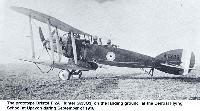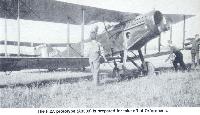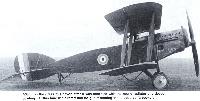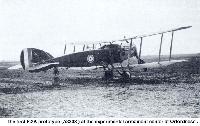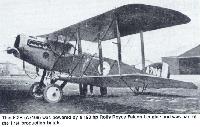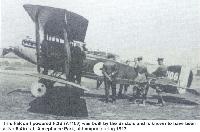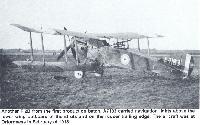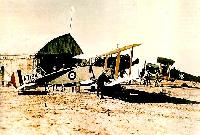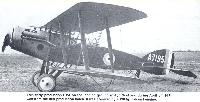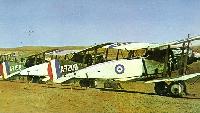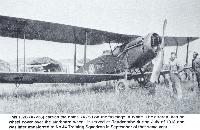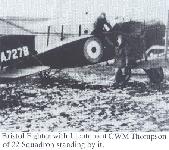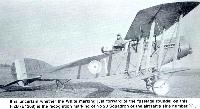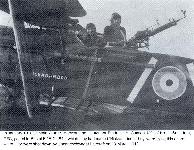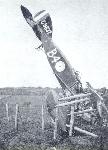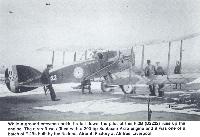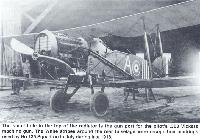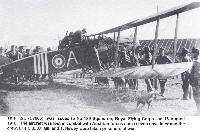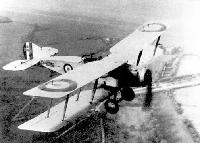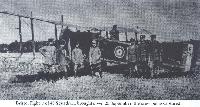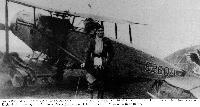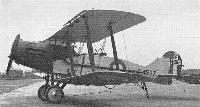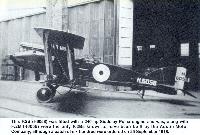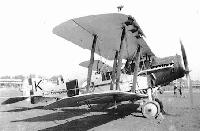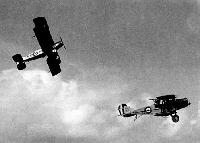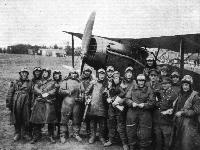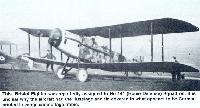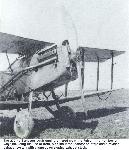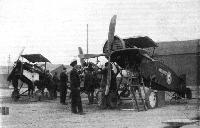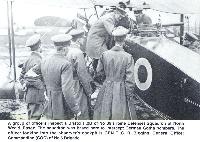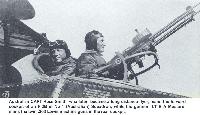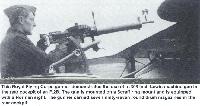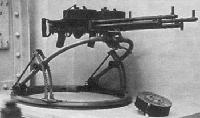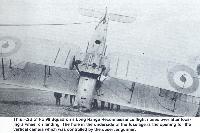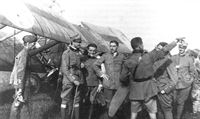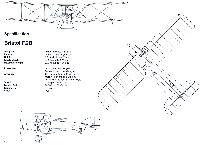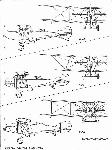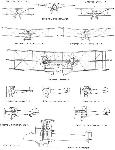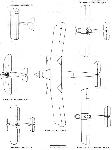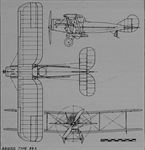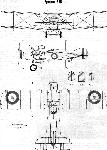В.Кондратьев Самолеты первой мировой войны
Бристоль F.2A/F.2B "Файтер" / Bristol F.2A/F.2B Fighter
Двухстоечный биплан цельнодеревянной конструкции с полотняной обшивкой. Спроектирован главным конструктором фирмы "Бристоль" Фрэнком Бэрнуэллом при участии авиаконструктора румынского происхождения Анри Коанда.
Двухместный аэроплан для воздушного боя под индексом F.2A и названием "Файтер" - "боец" (позже это слово приобрело в английском языке значение "самолет-истребитель") был создан в 1916 году на базе проекта разведчика R.2A/2B.
Летом и осенью 1916-го построены два прототипа F.2A, первый из которых был оснащен двухрядным двигателем жидкостного охлаждения Роллс-Ройс "Фолкон" в 190 л.с., а второй - аналогичным 150-сильным мотором "Испано-Сюиза".
Экземпляр с "Фолконом" впервые поднялся в воздух 9 сентября и в том же месяце запущен в серийное производство. Построено 50 экземпляров. В декабре сформирован первый дивизион "файтеров", а в марте он прибыл на Западный фронт.
Самолет заслужил хорошие рекомендации, и в июле военное министерство заказало еще 800 экземпляров машины в модификации F.2B, отличавшейся увеличенным размахом стабилизатора и улучшенным обзором из передней кабины. Первые 150 из них оснащались двигателями "Фолкон I", следующие 50 -"Фолконом II" в 220 л.с., а остальные - 275-сильным "Фолконом III".
С этим мотором самолет обладал великолепными летными характеристиками, став лучшим двухместным истребителем Первой мировой войны. Высокая скорость и хорошая маневренность позволяли ему на равных вести бои с одноместными истребителями, а наличие хвостовой огневой точки давало дополнительное преимущество. Кроме того, "Файтер" отличался большой прочностью конструкции планера. Предельно допустимая скорость пикирования достигала 390 км/ч - рекордный показатель для самолетов того времени.
С осени 1917-го до весны следующего года англичане перевооружили "Файтерами" шесть истребительно-разведывательных дивизионов Западного фронта. Кроме того, F.2B воевали в Палестине, Италии и состояли на вооружении пяти дивизионов ПВО.
Объем заказов Королевских ВВС на Бристоль "Файтер" непрерывно нарастал, достигнув в общем счете 5000 экземпляров. Из них за время войны успели построить 3301 самолет, еще 378 сдали в послевоенный период. В связи с окончанием боевых действий остальные заказы аннулировали.
В связи с нехваткой "Фолконов" некоторые серийные машины были оснащены 200-сильными моторами Санбим "Араб" и отличались более низкими летными данными.
К концу 1918 года в RAF числилось свыше 2000 "Файтеров". Несмотря на послевоенные сокращения и обновления авиапарка, эти машины состояли на вооружении до 1932 года, что является своеобразным рекордом для боевого самолета, созданного в годы Первой мировой войны.
В 1918 году 50 "Файтеров" англичане отправили в США. Американская фирма "Кертисс" начала лицензионный выпуск машины под индексом O-1, оснастив ее местным 400-сильным мотором "Либерти". Но этот мотор оказался слишком громоздким и тяжелым для "Файтера". В итоге построили всего 27 экземпляров O-1. На фронт они не попали.
В 1920-м Польша получила от англичан в рамках военной помощи 120 F.2B. Эти машины использовались на заключительном этапе польско-советской войны. Кроме того, 40 экземпляров истребителя продано Бельгии и еще по несколько штук закупили Испания, Новая Зеландия, Австралия, Мексика и Китай.
МОДИФИКАЦИИ
F.2A - двигатель Роллс-Ройс "Фолкон I" мощностью 190 л. с. Вооружение - 1 синхронный "Виккерс" и 1 турельный "Льюис" в задней кабине. Построено 50 экземпляров.
F.2B - двигатель Роллс-Ройс "Фолкон I", "Фолкон II" (220 л.с), "Фолкон III" (275 л.с.) или Санбим "Араб" (200 л.с). Вооружение - 1 синхронный "Виккерс" и спарка "Льюисов" на турели "Скэрф" в кабине летнаба, до 130 кг. бомб. Построено 3629 экземпляров.
ЛЕТНО-ТЕХНИЧЕСКИЕ ХАРАКТЕРИСТИКИ
(с двигателем "Фолкон"III)
Размах, м 11,96
Длина, м 7,87
Высота 2,97
Площадь крыла, кв.м 37,68
Сухой вес, кг 877
Взлетный вес, кг 1261
Двигатель: Роллс-Ройс "Фалкон" III
мощность, л. с. 275
Скорость максимальная, км/ч 192
Скорость подъема на высоту
2000 м, мин.сек 6,30
Дальность полета, км 480
Потолок, м 6100
Экипаж, чел. 2
Показать полностью
А.Шепс Самолеты Первой мировой войны. Страны Антанты
Бристоль F.2В "Файтер" (Fighter) 1917 г.
Появление этой машины было вызвано изменениями в тактике применения истребительной авиации. Одиночные стычки переросли в столкновения крупных формирований противников.
Основным способом уничтожения противника стал заход с помощью маневров высшего пилотажа ему в хвост и открытие огня с максимально короткой дистанции. И если на бомбардировщиках и разведчиках появились хвостовые установки, то истребитель долгое время уходил из-под удара маневром. К концу 1916 года британской моторной промышленностью были созданы двигатели мощностью 250-300 л. с., что позволило создать двухместные самолеты со скоростными характеристиками одноместных. Такой машиной и стал самолет "Бристоль Бритиш энд Колониэл Эйрплэйн Компани" F2В "Файтер". Машина была классическим двухстоечным бипланом деревянной конструкции. Отличался он от других британских машин тем, что фюзеляж прямоугольного сечения, обтянутый полотном, был приподнят над крылом. Это было сделано для обеспечения обзора пилоту и сектора обстрела стрелку. Крыло двухлонжеронное, обтянутое полотном, оборудовалось элеронами. Стойки бипланной коробки - металлические трубы в деревянных каплевидных обтекателях. Растяжки - профилированные стальные ленты. Оперение обычной схемы, стабилизатор, регулируемый на земле. Конструкция деревянная, обтянута полотном. Двигатели на машину ставились разные, но в основном - "Роллс-Ройс" "Фалкон II" или "Фалкон III", 12-цилиндровые, V-образные, жидкостного охлаждения, оборудованные четырехлопастным винтом и лобовым сотовым радиатором. Вооружение - 2 синхронных пулемета 7,69-мм "Виккерс" и спаренная установка пулеметов 7,62-мм "Льюис" на турели у стрелка. Самолет впервые взлетел в середине 1917 года, а с начала 1918-го стал поступать в войска, в том числе и в английские эскадрильи на Итальянском фронте, в Греции и на Ближнем Востоке.
Во время интервенции несколько машин попали и в Россию. После войны эти двухместные истребители оставались на вооружении ВВС Британии и некоторых европейских государств.
Показать полностью
В.Шавров История конструкций самолетов в СССР до 1938 г.
"Бристоль-Файтер" - двухместный истребитель и разведчик с двигателем "Испано-Сюиза" в 300 л. с., двухстоечный биплан, в котором фюзеляж находился над нижним крылом, не примыкая к нему. Выпущенный в 1918 г. этот самолет по летным данным мало уступал одноместным истребителям с тем же двигателем. Был приобретен в двух экземплярах для ознакомления, применялся в школах.
Самолет||
Год выпуска||1919
Двигатель , марка||
мощность, л. с.||300
Длина самолета, м||7,55
Размах крыла, м||11,9
Площадь крыла, м2||37,6
Масса пустого, кг||880
Масса топлива+ масла, кг||170+30
Масса полной нагрузки, кг||400
Полетная масса, кг||1280
Удельная нагрузка на крыло, кг/м2||34,1
Удельная нагрузка на мощность, кг/лс||4,3
Весовая отдача,%||31,3
Скорость максимальная у земли, км/ч||206
Скорость посадочная, км/ч||75
Время набора высоты||
1000м, мин||3
2000м, мин||6
3000м, мин||10
4000м, мин||14,5
Потолок практический, м||6200
Продолжительность полета, ч.||2,6
Дальность полета, км||480
Показать полностью
C.Barnes Bristol Aircraft since 1910 (Putnam)
The Bristol Fighter F.2A and F.2B
By March 1916 the Company had contracts for over 600 R.E. two-seaters of various types, and had delivered over 400; a further 550 B.E.2d and B.E.2e were to be produced before production of official designs ended in 1917. The shortcomings of the B.E. series and the requirements of the War Office for new designs were well known to Capt. Barnwell, and he held no high opinion of the R.E.5, the Royal Aircraft Factory's designated successor to the B.E.2e, so he set about producing a similar biplane having none of its defects. The result was the R.2A, which was laid out in March 1916 as a light two-seater powered by a 120 h.p. Beardmore engine, with the pilot in the front cockpit, with a synchronised Lewis gun on the starboard upper longeron, and an observer close to him in the rear cockpit, which contained dual controls, wireless, camera and message-launching tube. The observer could fold his seat and stand up to fire a single Lewis gun carried on a rotating ring mounting. To improve the observer's field of fire, the fuselage tapered to a very small cross-section aft, and more than a third of the fin and rudder area was below tailplane level. For the same reason, the fuselage was mounted high between the staggered wings, so that the observer could fire over the pilot's head at quite low elevations. The upper wing was thus placed so as to minimise the pilot's blind spot. The design was promising though underpowered, and it was hoped that a 150 h.p. Hispano-Suiza engine might be released later, so in May 1916 a modified design, R.2B, was sketched round this engine. This had wings of unequal span with a partial Warren girder lift bracing intended to simplify rigging in the field. Then in July Barnwell was offered one of the new 190 h.p. Rolls-Royce engines as well as the Hispano-Suiza, and he immediately redesigned the R.2A to suit both engines. He was not content to adapt what he had already drawn, but started afresh from the Rolls-Royce installation diagram, designing a new cowling and fuselage to accommodate all the R.2A's equipment in perfect harmony with the new fuel and oil tanks required; at the same time he incorporated the latest improvements in armament.
He sent Frise on a fortnight's course on the Vickers gun at Hythe, with instructions to find out all about it. Frise returned with the information and a complete Vickers gun as well. Various positions for it were tried, but in the end Barnwell decided that only a mounting on the centre line would be satisfactory, with the cocking handle immediately in front of the pilot, so that jams could be readily cleared. This involved making a tunnel through the upper fuel tank, but this complication had the advantage of keeping the gun in the warm air behind the engine, free from stoppages from frozen oil. The tail unit was redesigned and the top of the fuselage cambered to a horizontal knife-edge stern, thus reducing still more the observer's blind area. The rear cockpit arrangement was also revised, and the observer's tip-up seat was mounted to slide fore-and-aft so that he could sit facing either way. This gave him a better look-out while using his wireless and placed him within arm's reach of the pilot to give him instant warning of attack by a thump on the shoulder. An important innovation was the adjustable tailplane, whose incidence could be varied to give stable' hands-off' flying over a wide range of speeds. The dual control was removed, but a small emergency lever could be plugged into a socket for elevator control, and there were hand-grips on the rudder cables, which enabled the observer to minimise the effect of a crash landing with a dead or unconscious pilot. The new design was renamed F.2A to mark its ability as a fighter, and 'Bristol Fighter' was the name universally bestowed on it from the start. The Company was instructed to proceed at once with two prototypes, one with the Rolls-Royce engine and the other with the Hispano-Suiza. On 28 August 1916 a contract was awarded for the two prototypes and 50 production aircraft.
Work commenced on the two prototypes during July, and the first, No. 1379 (A3303), was ready for flight on 9 September 1916; the second, No. 1380 (A3304), followed on 25 October. The first flight was eagerly awaited by everyone in the factory, and there was dismay when Capt. Hooper reported that he was unable to climb higher than 6,000 ft. Rigging was checked but small alterations of incidence and stagger had no effect, and finally Capt. Barnwell sent for his brother Harold, Vickers' chief test pilot, who in turn reported a maximum altitude of 6,000 ft., although he felt certain he had climbed very much higher. Then the penny dropped, the altimeter was changed and the fault was found. In fact, the F.2A had climbed to 10,000 ft. in 15 min. A3303 was flown to Upavon on 21 September, and in its official trials exceeded its estimated performance by a handsome margin. Originally, the Rolls-Royce installation had two separate radiators mounted vertically on either side of the fuselage just ahead of the wings. This arrangement obscured the pilot's view for landing, and a new circular radiator was designed to fit into the nose, equipped with shutters in front; a similar radiator, but with shutters behind, was installed on the second prototype. As further Hispano-Suiza engines were not immediately available, Rolls-Royce engines were standardised for production aircraft, and in November the contract was amended to call for 200 more of an improved model, the F.2B. In accordance with A.I.D. recommendations the gap in the lower wing was filled by a lower centre section, and the upper longerons forward of the pilot's cockpit were sloped down so as to improve the view. All production Bristol Fighters had raked wing tips instead of the B.E. shape chosen for the two prototypes. Production aircraft numbered 1431-1480 (A3305-A3359) for the 50 F.2A's and 2069-2268 (A7101-A7300) for the 200 F.2B's were assembled at Brislington, because Filton works were full of B.E.'s and deliveries began on 20 December 1916; six left the factory before the year ended, and the fiftieth was dispatched on 23 March 1917.
The second prototype, A3304, was modified to incorporate the F.2B's lower centreplane and sloping longerons, and these were approved for production; deliveries of the 200 F.2B's began on 13 April, but before this the first squadron of F.2A's had gone into action over Arras. Deliveries of Bristol Fighters had begun early in the year to experimental stations, where they were intensively flown in mock battle by pilots with front line experience. Their reports were enthusiastic, and two squadrons were formed and trained for the spring offensive of 1917. The first squadron, No. 48, received F.2A's in February and arrived in France on 8 March, but was held back from action in order to achieve the maximum surprise effect. Early in April the squadron was based at Bellevue, near Arras, under the command of Major A. Vere Bettington. As a result of numerous applications from experienced pilots and observers, weary of the odds against them and eager to fly the Bristol Fighter, No. 48 Squadron contained the cream of the R.F.C. and numbered more than one V.C. amongst its crews. All were convinced that the Bristol Fighter would prove fast and manreuvrable enough to outfly the notorious Albatros D.III's used in formations or 'circuses' by Baron von Richthofen to establish local air superiority.
On 5 April 1917 the first offensive reconnaissance over Arras was made by six F.2A's led by Capt. Leefe Robinson, V.C. They were met near Douai by Richthofen with five Albatros and attempted to fight back in the orthodox two-seater manner, with the pilots manreuvring to give their gunners a good field of fire, but four Fighters were shot down, two by Richthofen personally, and Leefe Robinson was taken prisoner. Six days later, four Fighters were attacked by four Albatros and shot down two of the latter without loss, but later in the patrol one had to return to Bellevue with a jammed gun and the other three were shot down by four more Albatros. On 16 April six more of No. 48 Squadron's machines patrolled over Douai for over half an hour without meeting any enemy, which beguiled the formation leader into straying too far downwind, so that five ran out of fuel while still over the enemy lines. All but one were burned by their crews to avoid capture, and this sequence of losses was a disastrous debut for the new Fighter, from which so much had been expected. Some of the pilots then began to fly the Fighters as if they were single-seaters, using the front gun for the main attack and the observer's only as secondary rear cover. Immediate and striking success resulted from this change of tactics, and on 30 April a patrol of six F.2A's fought their way home from Douai without loss. The tip was passed on to the second Bristol Fighter Squadron, No. 11, which had just re-equipped after flying Vickers Gunbus pushers.
No. 11 Squadron went into the line in May and for some weeks performed photographic reconnaissance without interference from the enemy. On 20 June 1917, the first attack by an Albatros was made on one of No. 11's Fighters, flown by Lt. A. E. McKeever with Sergt. Powell as observer, McKeever held his fire until his attacker crossed his sights at close range, when a short burst from the front gun proved decisive. He repeated the performance the next day and within a week had scored four victories. In September he met eight enemy fighters, shot down one and disabled five others, for which he was awarded the Military Cross. By the end of October he had destroyed 20 enemy aircraft and had won a bar to his M.C. On 30 November, returning from a long patrol into enemy territory, he was attacked by seven Albatros and two two-seaters. He shot down one of the latter and in the melee that followed three of the single-seaters were destroyed, two by Powell with the rear gun. This final demonstration of prowess not only gained McKeever a D.S.O., but proved the magnificent fighting ability of the Bristol Fighter, when handled by a determined crew, and similar feats by many other pilots soon avenged the early casualties suffered by No. 48 Squadron.
Both Nos. 48 and 11 Squadrons had received F.2B's as soon as they became available, and the production contract was twice revised until by July the quantity on order was 602. Capt. Hammond tested the first F.2B, A7101, on 10 April 1917, three days before its despatch to the Acceptance Park. Of this batch, the first 150 were fitted with the 190 h.p. Rolls-Royce engine, now named Falcon I, and 50 with the 220 h.p. Falcon II. Later the first 275 h.p. Falcon III was installed in A7177, and this engine was standardised for future production, as long as supplies lasted. With the extra performance the Falcon III provided, the Bristol Fighter was one of the really great aeroplanes of 1917 and 1918. In a letter to Capt. Louis Strange after his posting to the Central Flying School, Major Vere Bettington, C.O. of No. 48 Squadron, wrote from France on 13 May 1917:
"Regarding the Bristol, she is a topping fighting two-seater, the best here; not excepting the D.H. as she is much handier than that and communication between pilot and passenger in the Bristol is splendid whereas D.H.4 is not.... She is faster than the Hun two-seater but cannot touch the latest Albatros Scout for speed. Where she does score tremendously is in her power to dive, in this she is alone among English or Allied machines. Many Huns who have dived on the tail of one, missed and gone on diving, have been dived after, overtaken and destroyed. They are dived plumb vertically for thousands of feet until the noise is like that of a million sabres cleaving the air. The indicated speed on a Clift or Ogilvie Indicator is then generally 60 to 90 m.p.h. the second time round the dial. The indicator reads normally to 130 m.p.h. then a space so probably the speed is considerably over 230 m.p.h.... She loops well ... she will do a fine spinning nose dive (if held in but will come out soon if left alone).... She stands an enormous amount of punishment in the way of being shot about and several have been very hard hit and come home, to be written off charge as beyond repair.... The Norman sight for the Lewis seems to be awfully good; observers have done well with it and many a Boche diving on the tail of a Bristol possibly mistaking it for a wretched Quirk (B.E.) has been badly stung; up to now observers have got about as many Huns as the pilots have done with their front guns."
Production of the F.2B at Filton began with Nos. 2269-2518 (B1101-B1350), which were delivered between 18 July 1917 and 18 February 1918, while Brislington continued with Nos. 2851-2950 (C4801-C4900) delivered concurrently between 17 October 1917 and 2 March 1918. The B.E.2e line at Filton ended at last, and in July 1917 the War Office adopted the Bristol Fighter for the re-equipment of all fighter-reconnaissance squadrons; a second production line began at Filton with a contract for 500 placed on 4 September covering Nos. 2951-3450 (C4601-C4800) and (C751-C1050) delivered between 30 November 1917 and 28 May 1918. This was increased in October by a further 300 shared by both factories, Nos. 3451-3750 (C7801-C8100), which were delivered between 29 March and 11 July 1918. But the Bristol factories were already working to their limit and still more drastic steps were needed to accelerate production, large contracts being let from November onwards to firms outside the aircraft industry; these firms included Angus Sanderson and Armstrong-Whitworth, both of Newcastle-on-Tyne; Austin Motors and Harris & Sheldon of Birmingham; the Gloucestershire Aircraft Co. of Cheltenham; Marshall and Sons of Gainsborough; National Aircraft Factory No.3 (managed by Cunard) at Aintree; and the Standard Motor Co. of Coventry. Each of these undertakings received orders for between 100 and 500 airframes, the total number being nearly 2,000.
Soon it was obvious that Rolls-Royce Falcons could not be produced fast enough for all the Bristol Fighters ordered, and the first alternative sought was the Hispano-Suiza, of which the 200 h.p. geared version was being produced by the French motor industry and in England also by Wolseley Motors. As the power was less than that of the Falcon III, Fighters with the latter engine were reserved for fighter-reconnaissance squadrons and those with alternative engines were to be issued to corps-reconnaissance units. As there would still not be enough Hispano-Suizas to meet the whole programme, because of the concurrent adoption of the S.E.5a Scout which used only this engine, a second alternative engine, the 200 h.p. Sunbeam Arab, was chosen; at Filton, Arabs were specified for 300 Fighters, C751-C1050. Unfortunately all these engines had been rushed into production before being fully developed and suffered severely from 'teething troubles'. Wolseley-built Hispanos averaged only 4 hours' life before crankshaft failure; Brasier-built Hispanos were no better, and although those built by Mayen were more reliable, all these were taken for the S.E.5a programme. Only 80 out of a promised 1,800 Sunbeam Arabs had been accepted by the end of 1917, because of severe vibration, and even these gave endless trouble when installed. It was then hoped to use a larger Hispano-Suiza of 300 h.p. which, having direct drive, was immune from reduction gear trouble, and the Sunbeam Arab installation was modified to accommodate it, but this too was delayed in production.
The effect of these cumulative troubles and delays was to postpone the changeover from R.E.8's to Bristol Fighters from April 1918 till September, and large numbers of F.2B airframes delivered early in the year remained in storage and did not reach France in time to take any active part in the fighting, apart from Bristol-built Rolls-Royce machines. At the Armistice, the Royal Air Force had on charge about 900 of the latter and 720 with other engines, out of a total of 1,349 from Filton, 853 from Brislington and 1,600 from other contractors.
When supplies of both types of Hispano-Suiza failed, it was decided to substitute the Siddeley Puma of 240 h.p., but as this was a six-cylinder vertical engine it was difficult to install, and in particular the front gun had to be moved from its successful central position. Even the Puma was delayed in delivery, due to foundry difficulties. In the summer of 1918 the direct-drive 300 h. p. Hispano-Suiza at last became available, and this proved to be entirely reliable, but deliveries had hardly commenced before the war ended. It was the original Falcon-engined version which never failed in production and proved invincible in action. It equipped six squadrons in France, one in Italy, two in Palestine and five for home defence. The Arab-engined version also rendered valuable service with five long-range corps-reconnaissance flights in France.
In the great German offensive of March 1918, the Bristol Fighter squadrons in France took a major part in strafing the advancing enemy infantry, flying almost at ground level with guns blazing and blasting enemy batteries with 20 lb. Cooper and 112 lb. Hale bombs in support of the hard-pressed Third and Fifth Armies. Nothing came amiss to the Bristol Fighter. In the arid wastes of the Palestine desert, No. 67 (Australian) Squadron gained superiority over the enemy air forces in October 1917 with the arrival of five F.2B's, for the first time since the campaign began. The Australian pilot Capt. Ross Smith and his observer Lt. E. A. Mustar flew the same Bristol Fighter, B1229, throughout the campaign, during which time they destroyed 17 enemy aircraft between them and twice rescued the crews of other stranded machines.
On the home front daylight raids by Gotha bombers caused heavy civilian casualties and at first met little opposition, but on 7 July 1917 an attempt was made by Home Defence units to intercept the raiders. The only aircraft to get within range was a Bristol Fighter, and later the type was chosen to reequip three H.D. squadrons; they were equipped with a sight set to face forward at an elevation of 45 degrees from the pilot's eye. The rear gunner fired over the pilot's head at the same elevation while the pilot aimed the aircraft, and at 100 m.p.h. the trajectory remained straight for 800 yards. Rolls-Royce-engined fighters equipped the Home Defence squadrons and were painted matt dull green, with all white stripes and rings in the insignia obscured.
Although the Falcon installation varied only in minor detail during the entire period of production, there were several changes in external appearance when alternative engines were used. The 200 h.p. Hispano-Suiza employed a nearly circular radiator slightly taller than wide, and its oil tank was mounted externally beneath the cowling. The Sunbeam Arab at first had a similar radiator of larger area and more nearly rectangular, but the simple tubular engine mounting was found to be too flexible for this very rough-running engine and a deep braced girder had to be substituted making the bottom line of the cowling square and horizontal; this mounting was combined with an S.E.5a radiator for a time, but had to be increased in area for the 300 h.p. Hispano-Suiza, raising the top cowling to pent-roof shape. Finally an improved mounting and radiator was designed to accommodate either the Sunbeam Arab or the 300 h.p. Hispano-Suiza, and this pattern was standardized for 1918 production. The Puma installation, designed at Farnborough, resembled that of the D.H.9, with a similar underslung radiator. Some late Falcon installations had enlarged radiators with a squarer shape, and a few Fighters had the aircooled R.A.F.4d engine; most of these were flown for test purposes at Farnborough.
When the United States entered the war in 1917 the Bristol Fighter was among the British types proposed for large-scale production in America; 2000 were ordered first from the Curtiss Aeroplane and Motor Corporation of Buffalo, N.Y., and later from a group of other firms to be supervised by the Engineering Division of the Bureau of Aircraft Production at McCook Field, Dayton, Ohio; all were originally to be fitted with the 300 h.p. Hispano-Suiza, licence-built by the Wright-Martin Corporation. These plans met with approval from the Company, and several of the Filton staff went to America to supervise the arrangements, taking with them two sample airframes. To their dismay, they found that the engine actually chosen was the 400 h.p. Liberty 12, which was too heavy and badly installed. Capt. Barnwell predicted trouble but was overruled; when the first Curtiss-built F.2B flew and crashed he was proved correct, but the U.S. Army blamed the aircraft rather than the power plant, and only 27 of the contract were built, the rest being cancelled. Technical opinion at McCook Field was less biased and the two Filton-built aircraft were flown, one (P 30) with a 300 h.p. Hispano-Suiza and the other (P 37) with a 290 h.p. Liberty 8. P 37 crashed before any performance tests could be made, but on 18 November 1918 P 30 was flown by Major Schroeder to a height of 29,000 ft. above Dayton, an unofficial world's altitude record for which homologation was never sought. A Hispano-Suiza-engined F.2B variant with semi-monocoque veneer fuselage was built at McCook Field with the designation XB-1A (P 90) in July 1919, and 40 more were produced for the U.S. Army by Dayton-Wright in 1920.
Although production of Bristol Fighters by outside contractors ceased on 26 November 1918, the Company was allowed to continue deliveries of all machines contracted for and started at that date, and production at Filton continued until September 1919, by which time a total number of 4,747 Bristol Fighters had been completed, 2,081 at Filton, 1,045 at Brislington and 1,621 by other contractors. Contracts placed with the Company from March to September 1918 covered Nos. 3754-4253 (E2151-E2650) and Nos. 42575424 (F4271-F4970 and H1240-H1707). Of the last batch, 153 aircraft (H1240-H1389, H1399-1400 and H1407) were completed with Arabs and the final 18 (H1690-H1707) with Pumas; all the rest had Falcons. (Apparently only four F.2B's were included in Imperial Gifts to Dominion Air Forces in 1919: D7869 (later G-CYDP) and F4336 (later G-CYBC) to Canada, and H1557 and H1558 to New Zealand. H1248 (G-A UEB) was purchased ex-Disposals with a 300 h.p. Hispano-Suiza in 1920) The last three Rolls-Royce machines, H1687-9, were specially fitted with long-range tanks and dual controls, without armament. In addition 56 were taken over for completion from the Standard Motor Co., Nos. 5659-5714 (E5253-E5308), and delivered with Pumas.
When the Royal Air Force became re-established on a peacetime footing, the Bristol Fighter was adopted as the standard Army Co-operation type, and in December 1919 a new machine, No. 5893 (J6586), was tested with a wide range of desert equipment and a tropical cooling system for use in India and Iraq. This was followed by 214 similar new machines, Nos. 5894-6107 (J6587-J6800), and these together with successive batches of Fighters reconditioned in accordance with specification No. 21/21, totalling 415 machines during the next five years, were issued to the overseas squadrons of the R.A.F., which maintained law and order in Iraq, Baluchistan and the North-West Frontier of India. At home they equipped the four Army Co-operation Squadrons, well known for their message-hook technique as demonstrated annually at Hendon, also No. 24 (Communications) Squadron and the Royal Aircraft Establishment; amongst the R.A.E. stud was one with square-tipped metal wings of biconvex section, incorporating leading edge condensers for evaporative cooling experiments. All the reconditioned aircraft received new sequence numbers, but normally retained their original serials, although in 1925 a batch of 84 built from spares, Nos. 6721-6804, became J7617-J7699. After this batch a further 144 were reconditioned in 1926, and during that year one machine, H1420, was specially modified to a revised layout and exhaustively tested at the School of Army Co-operation, Old Sarum. This variant, which was structurally redesigned throughout for higher loads, was designated Bristol Type 96 and officially named Bristol Fighter Mark III, and 50 new aircraft, Nos. 7040-7089 (J8242-J8291), were delivered between 16 October and 23 December 1926. The final production batch consisted of 30 similar machines, but with dual controls instead of armament; these, Nos. 6988-7017 (J8429-J8458), were completed between January and June 1927 and included J8430 specially furnished as a personal transport for H.R.H. the Prince of Wales, for whom it was flown and maintained by No. 24 Squadron. The 3576th and last new Bristol Fighter to be built at Bristol for the Air Ministry was No. 7122, one of two Mark III's delivered to the R.N.Z.A.F., in July 1927, together with a dual-control trainer, No. 7120. All the Mark III's of the R.A.F. were converted in 1928 into Mark IV's with a still higher gross weight, strengthened longerons and landing gear, Handley Page auto-slots and enlarged fin and horn-balanced rudder. The prototype of the Mark IV was H1417, which initially had slot-and-aileron controls on a square-tipped upper wing.
Bristol Fighters Mark IV were issued to the Oxford and Cambridge University Air Squadrons in July 1928 until finally superseded in 1931, when a few were released for sale and came on to the Civil Register. Apart from Royal Air Force service, Bristol Fighters were supplied in small quantities to many foreign air forces, including Belgium, Greece, Mexico, Norway, Peru and Spain, as well as to Australia, Canada, New Zealand and the Irish Free State. A large proportion of these were sold in 1920-23 from war disposal stocks and were fitted with 300 h.p. Hispano-Suizas; in Belgium, S.A.B.C.A. acquired a manufacturing licence after 16, Nos. 6223-6238, with Frise ailerons and oleo landing gear, had been purchased new. Twelve similar new Fighters, Nos. 6510-6521, were supplied to Spain between July and October 1924, and ten more with further revised control surfaces and oleo landing gear, Nos. 7222-7231, went to Mexico in 1927. The grand total of all Bristol Fighters built, excluding the Jupiter-engined variant described later, was 5,252. The last Bristol Fighters in service, those of the R.N.Z.A.F., were scrapped in 1938, No. 7121 having crashed during air-firing practice at a range near Christchurch in February 1936. Only two Bristol Fighters now survive and are being preserved for posterity. One is E2581, still in its 1918 camouflage, in the Imperial War Museum, London; the other is D8096, maintained in airworthy condition and flown on suitable occasions by the Shuttleworth Trust, at Old Warden, Beds.
SPECIFICATIONS AND DATA
Types: R.2A, R.2B, F.2A and F.2B
Manufacturers:
The British & Colonial Aeroplane Co. Ltd., Filton and Brislington, Bristol
The Bristol Aeroplane Co. Ltd., Filton, Bristol;
Angus Sanderson & Co. Ltd., Newcastle-on-Tyne;
Sir W. G. Armstrong, Whitworth & Co. Ltd., Gosforth and Elswick, Newcastle-on-Tyne;
Austin Motors Ltd., Longbridge, Birmingham;
Cunard Steamship Co. Ltd., National Aircraft Factory No.3, Aintree, Lancs.
Gloucestershire Aircraft Co. Ltd., Sunningend, Cheltenham;
Harris & Sheldon, Ltd., Stafford Street, Birmingham;
Marshall & Sons, Ltd., Gainsborough, Lincs.
Standard Motor Car Co. Ltd., Coventry;
Curtiss Aeroplane & Motor Corporation, Buffalo, N.Y., U.S.A.;
Dayton-Wright Airplane Co., Dayton, Ohio, U.S.A.
Engineering Division, Bureau of Aircraft Production, McCook Field, Dayton, Ohio, U.S.A.
Power Plants:
(R.2A) One 120 hp Beardmore;
(R.2B) One 150 hp Hispano-Suiza;
(F 2A)
One 190 hp Rolls-Royce Falcon I
One 150 hp Hispano-Suiza
(F.2B)
One 190 hp Rolls-Royce Falcon I
One 220 hp Rolls-Royce Falcon II
One 275 hp Rolls-Royce Falcon III
One 200 h.p. Hispano-Suiza
One 200 hp Sunbeam Arab
One 200 hp R.A.F.4d
One 180 hp Wolseley Viper
One 230 hp Siddeley Puma
One 300 hp Hispano-Suiza
(USA O-1)
One 400 hp Liberty 12
One 290 hp Liberty 8
Span:
(R.2A) 40 ft 8 in
(R.2B) 39 ft
(F.2A & F.2B) 39 ft 3 in
Length:
(R.2A) 26 ft 3 in
(R.2B) 25 ft 5 in
(F.2A & F 2B)
Falcon 25 ft 10 in
Arab & Hispano 24 ft 10 in
Puma 26 ft
(USA O-1)
Liberty 12 26 ft 2 in
Liberty 8 25 ft 5 in
Height: 9 ft 6 in
Wing Area:
(R.2A) 430 sq ft
(R.2B) 320 sq ft
(F.2A) 389 sq ft
(F.2B) 405 sq ft
Maximum Speed:
(F.2A: Falcon I) 110 mph
(F.2A: Hispano) 102 mph
(F.2B: Falcon III) 125 mph
(F.2B: Arab) 115 mph
(F.2B: Hispano 200) 115 mph
(F.2B: Puma) 116 mph
(F.2B: Hispano 300) 120 mph
(Mark II & III) 112 mph
(Mark IV) 110 mph
(USA 0-1) 138 mph
Service Ceiling: 20,000 ft
Endurance: 3 hours
Accommodation: 2
Weights:
Type Engine Empty Weight All-up Weight
F.2A Falcon I 1,700 lb 2,700 lb
Hispano 1,500 lb 2,500 lb
F.2B Falcon III 1,930 lb 2,800 lb
Arab 1,890 lb 2,800 lb
Hispano 200 1,740 lb 2,700 lb
R.A.F.4d 2,000 lb 2,800 lb
Puma 1,920 lb 2,810 lb
Hispano 300 2,070 lb 3,000 lb
Mark II Falcon III 2,095 lb 3,160 lb
Mark III Falcon III 2,150 lb 3,250 lb
Mark IV Falcon III 2,200 lb 3,350 lb
USA O-1 Liberty 12 - 2,940 lb
Показать полностью
O.Tapper Armstrong Whitworth Aircraft since 1913 (Putnam)
The Bristol F2B Fighter
By the year 1918, the F.K.8, which had been Armstrong Whitworth's main preoccupation in Newcastle since the autumn of 1916, was becoming obsolete and, in the spring of that year, production of this aircraft ceased and its place was taken by the Bristol Fighter, 250 of which had been ordered in February 1918.
The Bristol F2B Fighter, first produced in the autumn of 1916, was one of the outstanding aircraft of the First World War. Designed as a fighter-reconnaissance aircraft, the Bristol Fighter, with its high performance, combined the best characteristics of the fast, manoeuvrable, single-seat fighter with the fire power of the two-seater, and it proved itself to be a formidable opponent in the battles on the Western Front from the middle of 1917 onwards.
The engine of the standard Bristol Fighter was the Rolls-Royce Falcon, but production of this engine could not keep pace with the demand, and other powerplants had, perforce, to be used, with some inevitable loss of performance. One of the alternative engines was the 200 hp eight-cylinder water-cooled Sunbeam Arab, and it was this version that was ordered from Armstrong Whitworth. But the Arab engine was, itself, a disappointment: it suffered from severe vibration problems and, at some stage during the production run at Gosforth, the Siddeley Puma engine was substituted. This change-over probably occurred after the Armistice, by which time some sixty per cent of the order had been completed. The Bristol Fighter continued in production at Gosforth after the end of the war, but it cannot be confirmed whether or not all the 250 aircraft ordered, which were allotted the serial numbers E1901 to E2150, had been completed when, according to the company records, the contract was cancelled in September 1919.
Span: 39 ft 3 in (11.96 m)
Length: 24 ft 10 in (7.57 m)
Height: 9 ft 5 in (2.87 m)
Wing area: 405.6 sq ft (37.63 sq m)
All-up weight: 2.800 lb (1.270 kg)
Показать полностью
P.Bowers Curtiss Aircraft 1907-1947 (Putnam)
Bristol Fighter
One of the successful European combat aeroplanes selected by the Bolling Commission for mass production in the United States was the Bristol F.2B, better known as the Bristol Fighter. The US government owned the rights to the design and assigned the official designation of USAO-l as an observation type, but the Bristol Fighter name stuck. This was to be Americanized to the extent of having parts dimensions altered to be compatible with standard American tooling and altering the front end to accommodate the new 400 hp Liberty engine in place of the original British Rolls-Royce Eagle. Curtiss was given a contract for 2,000 in October 1917.
Production lines were set up in the new Elmwood Plant m Buffalo, and the first Liberty-powered Bristol was ready for flight in April 1918. The Liberty engine installation was troublesome from the start. It was both too heavy and too powerful for the relatively standard Bristol airframe and there were cooling problems. Because of the size of the Liberty, the original neat nose radiator of the Bristol could not be used; several arrangements of side and belly radiators were tried as well as fixed and movable units in the upper wing centre section.
Following several serious crashes of early test models, the Curtiss contract was cancelled after 26 Bristols had been completed (US Army serial numbers 34232/34257). This did not kill off official US interest in the design, however. While Curtiss tried to develop its own version of a Bristol replacement, the CB, the Air Service Engmeenng Division at McCook Field developed lower-powered versions with 300 hp Wright-Hispano engines and new laminated wood monocoque fuselages. Thirty of these were eventually produced by the Dayton-Wright Aircraft Company under the designation of USXB-1A.
Bristol Fighter (USAO-1)
Observation aircraft. Pilot and observer/gunner.
400 hp Liberty.
Span 39 ft 4 in (11,98 m): length 27 ft 1 in (8,25 m); height 10 ft 2 in (3,09 m); wing area 416 sq ft (38,64 sq m).
Empty weight 2,245 lb (1.018,3 kg); gross weight 3,500 lb (1.587,57 kg).
Maximum speed 125 mph (201,16 km/h) at sea level: climb to 10,000 ft (3,048 m) 7,05 min; absolute ceiling 25,000 ft (7,620 m): endurance 2 hr.
Armament - two fixed Marlin and two flexible Lewis machine-guns.
Показать полностью
O.Thetford Aircraft of the Royal Air Force since 1918 (Putnam)
Bristol Fighter
The Bristol Fighter, known affectionately as the ‘Biff‘ or ‘Brisfit’, was one of the mainstays of the RAF in its formative years. The first prototype (A3303), with a 190hp Rolls-Royce Falcon engine, flew late in 1916, and the first Fighters went into action with No 48 Squadron of the RFC over the Western Front in April 1917. With the formation of the Royal Air Force on 1 April 1918, the Fighter was in widespread service, and those of No 22 Squadron made the first sortie of the new Service at dawn on that historic day.
By the time that wartime contracts had been completed in September 1919, some 4,500 Bristol Fighters had been produced for the RAF', of which at least 350 were subsequently re-conditioned and reissued for post-war service. In addition, there were 380 acquired on contracts placed in the 1920s, of which 295 were newly-built and 85 built from spares. The new post-war Fighters became known as Mk Ils and met requirements for home service army co-operation as well as squadrons in India and Iraq, being fitted with message hooks and tropical equipment. The first Mk II (J6586) flew in December 1920. In 1925 the first Mk III appeared (H1420) with strengthened airframe and undercarriage, and increased all-up weights. The Mk III remained in production from 1926 until June 1927, and the final thirty were delivered as dual-control trainers, with the designation Mk III(DC). One of these (J8430) was assigned to No 24 Squadron as the personal aircraft of HRH the Prince of Wales. Serial numbers of the Mk Ils were J6586 to J6800 and J7616 to J7699, and for the Mk IIIs J8242-J8291 and J8429-J8458.
Bristol Fighters were to remain with nine squadrons of the occupation forces in Germany until No 22 finally left in July 1922. Meanwhile, in the United Kingdom, No 141 Squadron at Biggin Hill was despatched to Northern Ireland where six Bristol Fighter squadrons eventually served during the troubles preceding independence, the last to leave being No 2 Squadron in December 1922. Back in England, four squadrons served on army co-operation duties until 1931, when No 16 was the last to convert to the Atlas. No 24 Squadron at Kenley used Bristol Fighters for communications duties, including a unique example (H1460), known as the Coupe, with an enclosed rear cockpit.
On mandated policing duties overseas, Bristol Fighters did not leave first-line service until June 1932, when No 6 Squadron in Palestine reached its full establishment of Fairey Gordons. In India, where Bristol Fighters had first equipped No 31 Squadron from June 1919 and completed their first operation against recalcitrant tribesmen in September, they soldiered on until March 1932 with No 20 Squadron, which then reequipped with Westland Wapitis.
In the Middle and Near East, Bristol Fighters made their first appearance in Palestine in February 1919 with No 111 (later No 14) Squadron, in Mesopotamia with No 6 at Baghdad West in July 1920, and in Egypt with No 208 Squadron at Ismailia in October 1920. No 208’s Bristol Fighters were the last to leave this theatre in May 1930 when they received Atlases.
The final variant of the type to enter service was the Mk IV, immediately recognisable by its tall fin and rudder, the first and only change to the classic F2B outline. This was a dual-control trainer with a strengthened airframe, automatic HP slats, a wider tailplane and the greatest all-up weight of any F2B at 3,350lb. All the Mk IVs were conversions, the first example being H1417 in 1927. Deliveries began to Oxford and Cambridge University Air Squadrons in July 1928. The Mk IV was withdrawn in 1931-32, but a solitary survivor (F4587) made an appearance at the RAF’s final Hendon Display in 1937.
Only two Bristol Fighters survive with original identity today. The fully airworthy D8096 is seen flying regularly at Old Warden (the Shuttleworth Collection) and E2581 resides at the Imperial War Museum at Lambeth.
TECHNICAL DATA (FIGHTER MK. III)
Description: Two-seat army co-operation or dual-control trainer. Wooden structure, fabric-covered. Maker's designation: Type 96.
Manufacturers: Bristol Aeroplane Co Ltd, Filton, Bristol. Widely sub-contracted.
Powerplant: One 275hp Rolls-Royce Falcon III
Dimensions: Span: 39ft 3in; length, 25ft 10in; height, 9ft 9in; wing area, 406sq ft.
Weights: Empty, 2,150lb; loaded, 3,250lb.
Performance: Max speed, 110mph at sea level, 108mph at 13,000ft; initial climb, 838ft/min; 11min 15sec to 10,000ft; endurance, 3hr; service ceiling, 20,000ft.
Squadron Allocations: Western Front, 1918: Nos 9, 11, 12, 22, 35, 39, 48, 59, 62 and 88. Italy 1918: No 139. Egypt and Palestine, 1918: No 111. Home Defence, 1918: Nos 33 (Filton and Tadcaster), 39 (North Weald, Biggin Hill, Hainault Farm and Sutton’s Farm), 76 (Catterick, Copmanthorpe and Helperby), 138 (Chingford) and 141 (Rochford and Biggin Hill).
Post-war Service: United Kingdom: Nos 2 (Andover, Digby and Mansion), 4 (Farnborough), 13 (Kenley and Andover), 16 (Old Sarum), 24 (Kenley) and 141 (Biggin Hill). Southern Ireland (1919-22): Nos 2 (Fermoy and Oranmore), 4 (Baldonnel), 100 (Baldonnel), 105 (Fermoy, Oranmore and Omagh), 106 (Fermoy) and 141 (Baldonnel and Tallaght). Belgium: No 88. Egypt: Nos 111 and 208. France: No 35. Germany, Army of Occupation: Nos 8, 9, 11, 12, 22, 39, 48, 59 and 62. India: Nos 5, 20, 28, 31, 48 and 114. No 6. Palestine: Nos 14
and 111. Shanghai: No 2. Syria: No 14. Turkey: Nos 4 and 208.
Показать полностью
L.Andersson Soviet Aircraft and Aviation 1917-1941 (Putnam)
Bristol F.2B Fighter
The Bristol F.2B Fighter, of which one (2049, possibly ex-E2049) was captured by the Red Army during the Civil War, was a two-seat reconnaissance, light bomber and fighter aircraft. It was easily recognised by having its fuselage mounted midway between the upper and lower mainplanes, with a gap between the lower wing and the fuselage. Armament consisted of one forward-firing machine gun, one or two machine-guns mounted on a ring in the observer's cockpit and up to 120kg of bombs. The F.2A first flew in September 1916 and about 4,500 were built until 1919 of the F.2B model, which served with the RAF in great numbers and was also used by the air forces in Afghanistan, Argentina, Belgium, Canada, Greece, Honduras, Hungary, Ireland, Mexico, New Zealand, Norway, Peru, Poland, Spain, the USA and Yugoslavia.
A second example (identified as c/n 1088) was obtained in Britain in connection with other aircraft purchases for evaluation and was delivered in May 1922. It was assigned to the Martinsyde-equipped 2nd Otdel'naya istrebitel'naya aviatsionnaya eskadril'ya in Moscow after being tested and the other F.2B was issued to the 2nd Otdel'nyi istrebitel'nyi aviatsionnyi otryad in Kiev after it had been repaired. Both were used as trainers until withdrawn from use in 1925.
300hp Hispano-Suiza 8Fb
Span 11.97m; length 7.57m; height 2.9m; wing area 37.63m2
Empty weight 940kg; loaded weight 1,360kg
Maximum speed 191km/h; landing speed 75km/h; climb to 2,000m in 7.2min; ceiling 6,100m; endurance 3hr
Показать полностью
H.King Armament of British Aircraft (Putnam)
Fighter. The Bristol Fighter of 1916/17 endures in history as a preeminent example of an aeroplane designed round its armament. Not only is this quite literally true of the fixed-gun installation, but in the concentration of the crew and the studied provision of an effectively emplaced free gun - this to afford not only rear protection, but to augment the pilot's fire-power for attack. Allied with excellence of all-round performance and manoeuvrability, these qualities had their summation in an aircraft of which Oliver Stewart has declared that it 'should be spoken of in terms of the heroes of classic mythology', being 'in the fullest sense a hero after their pattern a fighter by name, inclination and aptitude'.
With this aeroplane the name of Frank Barnwell is identified, and it may have been Barnwell himself who declared: 'The fuselage is of rectangular section tapering to the rear to a horizontal knife-edge, thereby enabling the various tail members to be brought down low, out of the way of the gun. The top of the fuselage is kept flat for this purpose also.' It was further explained that, in order to bring the position of the pilot and the gunner as high as possible in relation to the top plane without increasing the depth of the fuselage, the latter was placed between the wings. In 1929 Barnwell remarked in a letter: 'I'm not sure that the happy guesses often years or so ago did not produce as efficient machines as many present-day ones. We've got performance by piling on BMP but this is not per se advance.' Yet Barnwell's masterpiece, the Bristol Fighter, was no mere happy guess. It evolved, in fact from 1916 designs for a two-seat reconnaissance aircraft along generally similar lines but armed with a synchronised Lewis gun to starboard and a second Lewis gun on a pillar-type mounting at the rear. This gun could be stowed in the fuselage decking as on much later multi-seaters. Field of fire was very carefully studied. Meanwhile Barnwell had been watching armament development and his fancy fell upon the Vickers gun for pilot use. Forthwith his assistant. L. G. Frise, was sent off on a Vickers-gun course at Hythe, and, as soon as Barnwell had learned all that he needed to know concerning the gun, he decided that it should be on the centre line of his new aeroplane with the breech casing to the pilot's hand even though this involved forming a tunnel through the petrol tank. And there it went, its presence being proclaimed only by the sights, frontal port, and low-sited ejection chute in the port side of the cowling. Proximity to the engine served to keep the lubricating oil relatively warm. The belt box was immediately behind the petrol tank and was tilled through an access panel in the top fuselage decking on the starboard side, between the centre-section struts. When the Siddeley Puma engine was installed it became necessary to move the Vickers gun to starboard, and the front of the gun was then exposed near the front centre-section strut. The gunner's Lewis gun was on a Scarff ring-mounting, attached to the upper longerons immediately behind the pilot. Six or more double drums were provided, and there were firing steps and a folding seat. Production-type Fighters had both ring-and-bead and Aldis sights, the former bracketed to the top centre-section. The Aldis sight was offset to starboard and was fixed to a special fore-and-aft tubular mounting, likewise attached to the centre-section, and earning the two circular clamps. The C.C. gear was of 'B' type and the loading handle a Hyland Type B also. An official document of 1917, relating to the F.2B, gave the empty weight, including guns and mountings, as 1,700 lb and the weight of 'ammunition' as 150 lb. This figure, however, represents a total of about 2,000 rounds of 0.303-in ammunition and corresponds to the total military load for one known condition. Other figures quoted for military load are 180, 185 and 192 lb, but in this connection it must be noted that a load of up to twelve 20-lb bombs could be carried beneath the inner lower wings and centre-section. A Negative Lens bombsight could be fitted. On production aircraft the pilot's seat was not armoured as on the two prototypes.
How the earliest F.2A Fighters met disaster, until their pilots learned to use them as single-seaters with rear cover, is a thrice-told tale, but in basic armament there was little variation. On F.2Bs two Lewis guns were sometimes fitted on the ring-mounting, and on one machine at least there was a third Lewis gun, arranged to fire upwards and forwards over the top centre-section. For this gun there was a massive 'four-poster' mounting. By far the most interesting departure from standard was made on Home Defence F.2Bs for night fighting, following a similar experimental installation on an F.2A. A Neame illuminated sight was fitted on the centre-section, pointing upward at an angle of 45 degrees from the pilot's eye. The pilot took aim, and the gunner, having aligned his gun accordingly, fired on receiving a signal from the pilot. A device enabling the pilot to rotate the gun mounting himself is said to have been fitted, though the virtue of this is not apparent.
A confirmed installation of the greatest interest was the tilting of one of the earliest Browning aircraft machine-guns (Model 1918, M1, Cal .30) on a Bristol Fighter F.2B during 1918. In general pattern this gun was similar to that which armed the Hurricane and Spitfire in the Battle of Britain, a fact which is clearly apparent in the photograph on page 93.
In post-war years the Bristol Fighter was adapted for army co-operation and general purpose duties, and during early 'A.C.' trials the guns were unshipped to make weight allowance for heavy wireless gear. In 1921 an Air Ministry order instructed that the 'C' type C.C. gear would in future be standard on all Falcon-engined Bristol Fighters, in conjunction with a new-type nose-piece for the engine in which the generator brackets were incorporated in the castings.
The last honoured years of the Bristol Fighter in RAF service have been fittingly expressed by one who shared them, thus:
'The Brisfit of North-West Frontier vintage actually carried an operational load of eight 20-lb Coopers and one 112-lb H.E. The latter was sometimes replaced by a can of 200 B.I.B. incendiaries. This was, of course, in addition to the front and rear guns, extra tropical radiator and an extra fuel tank under the rear seat. For squadron transport purposes the load was slightly different. Two bundles of bedding, complete with mosquito nets and poles (with galvanised-iron wash-bowls as nosepiece) were lashed to the wing bomb racks'.
The last variant (Mk.IV) could carry two 112-lb bombs.
Показать полностью
P.Lewis The British Fighter since 1912 (Putnam)
Although neither the T.T.A. nor the S.2.A passed into production, Frank Barnwell’s next two-seat fighter design for the British and Colonial Aeroplane Company was destined to be an outstanding success and to have many years of excellent service ahead of it.
By the beginning of 1916, it had become quite obvious that a replacement was imperative for the primitive and obsolete two-seaters plodding their way warily across the increasingly dangerous skies over the Front. By March of that year, Barnwell was able to settle down to transferring to paper his idea of an advanced and powerful new two-seater. With a considerably enhanced fund of experience to draw upon, his versatile mind devised a layout for a biplane of eminently purposeful aspect.
At first the new project was known as the R.2A with the intended engine to be the 120 h.p. Beardmore. To obtain the desired performance it became obvious that more than 120 h.p. would be needed and thought was given to using the more powerful Hispano-Suiza as an alternative. Barnwell’s mind was finally made up for him by the advent at a most propitious time in April, 1916, of a newcomer to the range of Rolls-Royce aero engines - the twelve-cylinder water-cooled V Falcon of 205 h.p. Never satisfied that significantly increased output could not be gained by intensive development, Henry Royce was able steadily to improve the rating to 228 h.p. in May, 247 h.p. in February, 1917, and 262 h.p. by April, 1917.
The Falcon was a gift to Barnwell of a fine, reliable, powerful engine around which he proceeded to completely redesign the R.2A as the Bristol F.2A Fighter. The power unit was well blended into a fuselage of rectangular section which tapered in side elevation to a knife-edge at the tail, and which was suspended by struts between the two-bay, equal-span wings. In deference to the essential requirement in a two-seat fighter that the pilot and gunner should be able to communicate immediately with each other, the cockpits were adjacent and in every other way the needs of the crew for their utmost efficiency were borne in mind in the layout. The pilot’s view was enhanced by adequate stagger of the wings and by cut-outs in the centre-section trailing edge and roots, while the gunner was given as broad a field of fire as could be arranged.
Two prototypes were soon ordered but incorporating different engines - one with the Falcon Mk.l and the other with the 150 h.p. Hispano-Suiza. Work on the airframes was started during July, 1916, and 9th September saw the Falcon-powered A3303, the first machine, ready. Modification to the engine’s radiators soon took place when the pair originally fitted, one on each side of the fore-fuselage, were removed to improve the view for the pilot and replaced by a neat installation around the nose ahead of the engine. A3304, the Hispano-Suiza-powered F.2A, was complete some six weeks later on 25th October. The F.2A’s pilot was provided with a single Vickers gun installed in the centre of the nose and covered by the cowling so that it fired through an orifice in the radiator face. The observer’s Lewis was carried on a Scarff ring.
The F.2A was an instant success and went through its trials with flying colours to achieve performance figures which exceeded those expected. An initial order for fifty was placed, to be powered with the Falcon to circumvent the shortage of Hispano-Suizas, and with revised wingtips.
The first operational squadron to use the F.2A was No. 48, which went into action with the machine on 5th April, 1917, but suffered unexpectedly high losses immediately owing to the lack of appreciation by the crews of the vastly superior capabilities of their mounts compared with previous two-seaters. Once the speed and great manoeuvrability inherent in the Fighter were recognized, the machine came into its own in combat with the pilot able to use his gun really effectively and the observer simultaneously making the most of his armament. The technique which had to be learned and exploited was one of flying and fighting with the machine in a manner hitherto reserved for a single-seater.
Even after the deletion of the side radiators, the forward view from the pilot’s cockpit was still not all that it could be and was improved by incorporating downward slope in the upper longerons from the rear cockpit forward to the bearers for the engine. The modified machine went into production as the F.2B and proceeded to enhance the reputation already earned by the F.2A.
The Biff, as it soon became affectionately known, proved itself to be a brilliant design and an outstanding success among the British warplanes of 1914-18.
Although the Sopwith 1 1/2-Strutter had pioneered the two-seat armed tractor layout successfully, Frank Barnwell’s Bristol Fighter marks the start of the classic concept and employment in battle of the single-engine, two-seat, high-performance fighter, born in the heat of war and continued into the years of peace as a type of aircraft in the development of which British designers excelled. Provided that sufficient power were available from the engine, around which the machine was designed, the two-seat fighter could prove itself to be a very welcome and useful addition to air strength. The twin-engine multi-seat concept for a fighter was a far less happy combination owing to the attendant drastic sacrifice of manoeuvrability, which its size and layout involved, and which was not a pronounced feature of the single-engine formula. Some loss of performance was inevitable in the two-seat fighter, owing to increased size and the extra weight of airframe and gunner, but the Bristol Fighter was able to offset these disadvantages handsomely by virtue of its excellent, powerful Rolls-Royce engine.
Показать полностью
F.Mason The British Fighter since 1912 (Putnam)
Bristol F.2A
In March 1916 Frank Barnwell began the design of a new two-seat fighter embodying many of the lessons learned from the Royal Aircraft Factory’s B.E.2 (of which Bristol had produced several hundreds). Intended to use the 120hp Beardmore engine, this design was referred to as the R.2A, and was a fairly large two-bay biplane with wings of equal span; the pilot’s cockpit was located under a large trailing edge cutout, and his observer/gunner was situated close behind with a Lewis gun on a Scarff ring. A single synchronized Lewis gun was mounted forward on the upper starboard longeron. It was realised that the R.2A would be somewhat underpowered and in May the design was altered to introduce a 150hp Hispano-Suiza, and to feature wings of unequal span and part-Warren girder interplane struts; this was the R.2B.
Two months later Bristol was offered one of the new 190hp Rolls-Royce vee-twelve water-cooled engines (soon to be named the Falcon I), and Barnwell undertook a fresh re-design, the F.2A, based largely on the R.2s and returning to the equal-span two-bay wings of the original design, but retaining the sprung tail skid of the R.2B. The front Lewis gun was changed to a Vickers and re-positioned in the centre of the nose where it was located in a tunnel through the front fuel tank; fifty gallons of fuel were carried in two tanks, sufficient for 3 1/4 hours’ flying.
The fuselage box girder structure was strengthened and an adjustable-incidence tailplane incorporated, permitting the aircraft to be flown ‘hands-off over a wide speed range. The rear fuselage was given more pronounced taper in side elevation, thereby slightly increasing the observer/gunner’s rearward field of fire. Wireless equipment was to be provided as a standard fitting. One of the characteristic features of the F.2 family that would become familiar for many years was the continuous lower wing structure which was located about ten inches below the fuselage, being ‘carried’ by struts attached to the lower fuselage longerons. The centre section of this wing was an open structure with steel carry-through spars without fabric covering. The wings, with top and bottom ailerons, were rigged with 17.1 inches of stagger.
The first prototype, A3303, was flown on 9 September at Filton by Capt C A Hooper, and went on to Upavon for Service evaluation on the 21st. It was soon found that the Falcon’s vertical radiators, mounted on the sides of the nose, obscured the pilot’s field of view during landing and a new nose configuration was designed to incorporate a single annular radiator within the engine cowling.
A second prototype, A3304, was flown on 25 October, this aeroplane being fitted with a 150hp Hispano-Suiza - also with front annular radiator. This was the version intended for production, but all Hispano-Suizas were now required for the Royal Aircraft Factory’s S.E.5, and an order was issued for fifty F.2As, to be powered by Rolls-Royce Falcon Is. The production version also featured blunt wingtips, a feature that was to remain unchanged in all subsequent F.2s.
These F.2As began delivery to the RFC in February 1917 and were issued to No 48 Squadron at Rendcombe, Gloucestershire, where a special training unit was formed for the Bristols’ crews. No 48, commanded by Maj A Vere Bettington (later Gp Capt, CMG, raf) flew to Bertangles in France on 8 March, moving on to Bellevue soon after. The Squadron’s debut in action on 5 April ended in disaster when six F.2As, led by Capt W Leefe Robinson vc, ran into five Albatros D IIIs, led by Manfred von Richthofen. Four of the Bristols were shot down, two of them by the enemy leader. Further casualties were suffered in the days following until it became apparent to the British pilots that the F.2A was being flown incorrectly in combat, and that relying wholly on the rear gun was to exploit only a small part of the fighter’s potential. Gradually the pilots began to fly their aircraft as if they were single-seaters, using the front gun offensively, and relying on the rear gun primarily for defence. Thereafter the Bristol’s true value was fully appreciated and, when the F.2B arrived soon after, the RFC found that it had a superb general purpose fighter.
[There was to be a curiously analogous combat twenty-three years later, when Boulton Paul Defiant two-seat turret fighters of No 141 Squadron, fighting their first combat in the Battle of Britain, encountered enemy Messerschmitt single-seaters over the English Channel. Once again the British pilots fought their fighters as gun platforms for their rear gunners and once more suffered catastrophic losses, six out of nine Defiants being destroyed. After the incident, however, there was to be no recourse to front gun armament - the Defiant had none.]
Type: Single-engine, two-seat, two-bay biplane general purpose fighter.
Manufacturer: The British & Colonial Aeroplane Co Ltd, Filton and Brislington, Bristol.
Powerplant: First prototype and production F.2As. One 190hp Rolls-Royce Falcon I 12-cylinder water-cooled in-line engine. Second prototype. 150hp Hispano-Suiza.
Structure: Wooden structure with duralumin, ply and fabric covering, reinforced locally with steel tubular members.
Dimensions: Span, 39ft 3in; length, 25ft 10 in; height, 9ft 6in; wing area, 389 sq ft.
Weights: Falcon I. Tare, 1,700lb; all-up, 2,700lb.
Performance: Falcon I. Max speed, 110 mph at sea level; climb to 10,000ft, 14 min 30 sec; service ceiling, 16,000ft; endurance, 3 1/4 hr.
Armament: One 0.303in Vickers machine gun in nose with Constantinesco CC interrupter gear, and one Lewis gun on Scarff ring in rear cockpit.
Prototypes: Two, A3303 (first flown on 9 September 1916 by Capt CA Hooper at Filton), and A3304.
Production: 50 aircraft (A3305-A3354).
Summary of Service: Bristol F.2As served with No 48 Squadron, RFC, in France, and at a training unit at Rendcombe.
Bristol F.2B Fighter
The first Bristol F.2 with alterations recommended by the AID during the F.2A trials was flown on 25 October 1916. These modifications included the covering of the lower wing centre section below the fuselage, and the angling downwards of the upper longerons from the rear of the front cockpit forward in order to improve the pilot’s view while landing. The first 150 F.2Bs, from a contract for 200 (A7101-A7300), retained the 190hp Rolls-Royce Falcon I of the earlier F.2A, but from A7251 onwards the 220hp Falcon II was fitted.
The next order for 250 aircraft introduced the definitive Falcon III of 275hp, and this engine remained standard for the Fighter for the remainder of the War and beyond - although several alternative engines were adopted when pressure on Falcon production increased sharply in 1918.
The Bristol F.2B Fighter was one of a handful of truly great British fighters of the War, alongside such aircraft as the S.E.5A, and Sopwith Pup and Camel. The shock defeat of No 48 Squadron, with its heavy losses of F.2As, might have had serious repercussions had the War Office concluded that the British fighters suffered a fundamental design flaw, and decided to cancel the large production contracts which had by then been negotiated. Fortunately it was the line pilots themselves who took matters into their own hands, changing tactics by employing the Fighter’s front gun offensively.
By the time No 11 Squadron, commanded by Maj Cuthbert Trelawder Maclean (later Air Vice-Marshal, cb, dso, mc, RAF), arrived in No 13 Wing at La Bellevue, the new tactics were paying off handsomely. On 20 June the Squadron drew first blood when an Albatros D III attacked a Bristol head-on, but was met and destroyed by a short burst from the British fighter’s front gun. The pilot of the F.2B was Lt Andrew Edward McKeever, a Canadian from Ontario who was to become the finest exponent of the two-seat fighter. This was his first victory, and by the end of the year (when he was posted to England as an instructor) he had destroyed a total of thirty enemy aircraft, of which eight fell to the gun of his observer, Sergeant L F Powell. McKeever was to be awarded the DSO and two MCs (and Powell the DCM), only to die on Christmas Day 1919 from injuries suffered in a car accident.
Such was the esteem in which the Bristol Fighter was now held that in July 1917 the War Office decided to standardize the aircraft on all fighter- and corps-reconnaissance squadrons of the RFC, replacing the B.E.2 and B.E.12 and, in due couse, the R.E.8 - a process that lasted well into the post-War years. On 2 September the parent company received an order for a further 800 F.2Bs (which it could meet as the B.E.2 production at Filton was coming to an end), and the following month orders for a further 800 were placed with three manufacturing sub-contractors.
Meanwhile No 20 Squadron (Maj E H Johnston) at St Marie-Capelie, and No 22 Squadron (Maj L W Learmont dso, mc) at Boisdinghem had received F.2Bs, replacing F.E.2s, and in September No 39 Squadron at Woodford, Essex, changed to F.2Bs for Home Defence duties. The same month a small number of Bristol Fighters joined the newly-formed No 111 Squadron in Palestine, joining Bristol Scouts, D.H.2s and Nieuports.
As the numbers of F.2Bs in France continued to grow, it became increasingly noticeable that German pilots were deliberately avoiding combat with them unless they possessed overwhelming numerical superiority. Even so, there were Bristol pilots who seemed undaunted by unfavourable odds. On 30 November 1917 McKeever and Powell encountered two German reconnaissance two-seaters escorted by seven Albatros single-seaters, and shot down both the former and two of the latter before making good their escape.
In 1918 the pace of production was further increased, with a total of 2,867 aircraft completed by Bristol and four sub-contractors (the latter producing 1,000 aircraft between them). Inevitably it was not long before Rolls-Royce reported that it would be unable to keep pace with engine demand, as production of both the Eagle and Falcon was already running at capacity, while the very large 600hp Condor would soon enter production. This situation had been foreseen some months earlier, but continuing indecision by the War Office had already led to delays in the delivery of engines. A number of alternative engines had been specified, including the 200hp Sunbeam Arab and the 200hp Hispano-Suiza, the latter being intended for aircraft built by the National Aircraft Factory No 3 at Aintree, Liverpool. The available Falcons were intended to be confined to aircraft built by Bristol, with Arabs suggested as suitable alternatives should airframe production outstrip engine availability. In the event only a tiny number of Bristol-built F.2Bs was completed with the Sunbeam engine.
These alternative engines underwent official tests in F.2Bs early in 1918, the Hispano-Suiza in B1201 during January, and the Arab in B1204 in March. The performance in both was most unsatisfactory and bestowed a much inferior performance compared with those aircraft with Falcons. Moreover, production of the 200hp Hispano-Suiza had encountered problems, and the reduced numbers available were reserved for the S.E.5A, with the result that the Hispano-powered F.2B was abandoned, and the NAF No 3-built aircraft were completed with Falcons.
Choice of the Arab had also been unfortunate. The engine had been ordered in considerable numbers as early as 1916, largely on the strength of design figures submitted before it had undergone rigorous testing. In January 1917 the engine had been ordered in quantity from the Auston Motor Company and from Willys-Overland in Canada. When the trials were completed in May that year, the engine was found to have serious cylinder and crankcase design faults, so that final drawings could not be issued until December. Production plans had called for 1,800 engines to be delivered by the end of 1917, but only 81 had been completed. Furthermore, when installed in the Bristol Fighter, it is said that engine life was an average of only four hours due to excessive vibration causing crankshaft failure.
Because of the much-reduced performance of the Arab engine, it was decided to confine it to F.2Bs entering service with Corps Reconnaissance squadrons in April 1918, and to issue Falcon-powered aircraft to the Fighter and Fighter-Reconnaissance squadrons. This was rescinded after the creation of the Air Ministry on 2 January 1918, and it transpired that Arab-powered aircraft were only used as replacements for second-line units.
By mid-1918 fifteen squadrons had been equipped with F.2B Fighters. Of these, Nos 11, 48 and 62 were flying primarily fighter patrols, including escort duties, over the Western Front; Nos 20, 22 and 88 Squadrons were performing fighter-reconnaissance duties in France; No 12 was engaged in Corps Reconnaissance (what would later be termed army co-operation), and would be joined by No 9 Squadron in July. Nos 33, 36, 39,'75, 140 and 141 Squadrons were based on airfields in England for home defence against German bombers and airships, and would be joined by No 76 Squadron soon after. Further afield No 34 Squadron was engaged in fighter-reconnaissance on the Italian Front, being joined by No 139 in July. In Palestine No 67 Squadron was flying fighter patrols in aircraft that had formerly been used by No 111 Squadron. One other Squadron, No 35, would begin to equip with Bristol F.2Bs in France, replacing Armstrong Whitworth F.K.8s for army co-operations duties, but was not fully operational before the Armistice in November.
Before going on to summarise the Bristol Fighter’s peacetime activities, it is necessary to mention some of the numerous experiments undertaken with the aircraft as it underwent a continuous programme of development. Engines which were flown experimentally in the aircraft included the 230hp Siddeley Puma (and a 290hp high-compression version), 200hp Wolseley Viper, 300hp Hispano-Suiza and 200hp RAF 4D; single-bay wings were flown on several test aircraft, and three-bay high aspect ratio wings were also flown, both types in 1923.
Although strictly outside the scope of this work, extensive plans were laid to build Bristol Fighters in the United States of America (on the recommendation of General Pershing), and with them to equip American forces, as that country had entered the War with scarcely a respectable modern military aeroplane. Unfortunately these plans were long delayed, partly due to an attempt to fit the unsuitable American Liberty 12 engine in the aircraft; various other American engines were tried, including the Liberty 8, Wright H, Curtiss D-12 and a 350hp Packard, but none produced any significant improvement over Frank Barnwell’s original design. In all, some 68 aircraft (including prototypes) were produced in America.
Post-War Service
The Armistice of November 1918 ended any immediate threat of air attack on Britain, and brought about enormous reductions in her air force, so much so that home-based interceptor fighter squadrons almost entirely disappeared in the post-War cutbacks. The Bristol Fighter, of which the new Royal Air Force possessed no fewer than 1,583 at the end of the War, had shown itself to be an excellent reconnaissance fighter, well suited to the role of army cooperation.
As the RAF assumed the role of air policing, under international mandate in the Middle East, squadrons equipped with D.H.9s and Bristol F.2Bs were sent out to, or re-formed at numerous foreign stations, many of them with very rudimentary landing strips. The majority of wartime F.2B squadrons remained in being only until 1919 or 1920, the exception being No 20 which, without even returning to Britain from the continent after the Armistice, was posted direct to India for service on the North West Frontier, continuing to fly Bristol Fighters until March 1932 - the longest term of service by an F.2B Squadron.
It had already been discovered that operating the Falcon-powered fighters in the harsh conditions of heat and dust in the Middle East during the War had resulted in very low serviceability among the aircraft, their engines frequently overheating and quickly wearing out. The Royal Aircraft Establishment (formerly the Factory) at Farnborough undertook a programme of trials to find means by which these problems might be overcome. Early remedies included the simple expedient of cutting extra louvres in the engine cowling to allow unrestricted airflow through the frontal radiator; radiator shutters were removed and, eventually, tropical radiators with coarse matrices were introduced; aircraft thus built or modified became Bristol Fighter Mark Ils, and also carried desert survival equipment.
In due course aircraft engaged in operations, particularly on the North West Frontier of India, were required to carry up to twelve 20-pound Cooper fragmentation bombs, and this in turn demanded local strengthening of the airframe; these aircraft were termed Mark IIIs. In 1926 further design changes introduced Handley Page slots on the upper wings, revised upper fin and an enlarged, horn-balanced rudder and further strengthening of the undercarriage, aircraft with these modifications being Mark IVs. And all the while the Rolls-Royce Falcon III remained the standard engine.
At home a total of four army cooperation Squadrons (Nos 2, 4, 13 and 16) continued flying F.2Bs until the late nineteen-twenties, and No 24 Squadron flew them on communications duties. Nos 5,20,28 and 31 were equipped with successive versions in India and on the North West Frontier until the early nineteen-thirties, as Nos 6, 14 and 208 served on various stations throughout the Middle East (Nos 4 and 208 Squadrons were also engaged in the brief activities in Turkey during and after the Chanak crisis of 1922, and No 2 was sent to China for several weeks in 1927 to protect the international settlement at Shanghai).
The ‘Brisfit’ was a very popular aeroplane among its crews throughout its long service, largely thanks to its excellent Rolls-Royce Falcon engine; it was a sturdy aircraft, capable of withstanding considerable combat damage in war, and rough field conditions before the age of metalled runways.
Type: Single-engine, two-seat, two-bay biplane army co-operation reconnaissance fighter.
Manufacturers (in Britain): The British & Colonial Aeroplane Co Ltd (Bristol Aeroplane Co Ltd), Filton and Brislington, Bristol; Sir W G Armstrong, Whitworth & Co Ltd, Newcastle-upon-Tyne; The Gloucestershire Aircraft Co Ltd, Cheltenham; Harris & Sheldon Ltd, Birmingham; Marshall & Sons, Gainsborough; National Aircraft Factory No 3, Aintree, Liverpool; Angus Sanderson & Co, Newcastle-upon-Tyne; The Standard Motor Co Ltd, Coventry; The Austin Motor Co (1914) Ltd, Birmingham.
Air Ministry Specification: Spec 21/21 covered post-War re-building and reconditioning of wartime aircraft.
Powerplant: One 190hp Rolls-Royce Falcon I twelve-cylinder liquid-cooled in-line engine; 220hp Falcon II; 275hp Falcon III; 200hp Sunbeam Arab; 200hp Hispano-Suiza; 300hp Hispano-Suiza; 230hp Siddeley Puma; 290hp Siddeley Puma (high compression); 200hp RAF 4D; 200hp Wolseley W4A Viper; 290hp Liberty 8; 400hp Liberty 12.
Structure: All-wooden construction with ply and fabric covering.
Dimensions: (Falcon) Span, 39ft 3in; length, 25ft 10in; height, 9ft 9in; wing area, 405.6 sq ft.
Weights: (Falcon III) Tare, 1,934lb; all-up, 2,779lb.
Performance: (Falcon III) Max speed, 126 mph at sea level, 105 mph at 15,000 ft; climb to 10,000ft, 11min 15 sec; service ceiling, 20,000ft; endurance, 3 hr.
Armament: One fixed, synchronized 0.303in Vickers machine gun mounted centrally beneath nose cowling with Constantinesco CC interrupter gear, and one or two Lewis guns on rear cockpit Scarff ring; later aircraft could carry up to twelve 20lb Cooper fragmentation bombs under the lower wings.
Prototypes: See Bristol F.2A
Production: (in Britain) Total of 5,329 built. (Bristol, 3,451: A7101-A7300, Bl 101-B1350, C751-C1050, C4601-C4900, D7801-D8100, E2151-E2650, E5253-E5308, F4271-F4970, H1240-H1707, J6586-J6800 (Mk II), J7617-J7699 (Mk II), J8242-J8291 (Mk III), J8429- J8458 (Mk III); Gloster, 550: C9836-C9985, E9507-E9656, H834-H1083; Austins, four known: H6O55-H6O58; Armstrong, Whitworth, 250: E1901-E2150; Harris & Sheldon, 100: F5074-F5173; Marshalls, 150: D2626-D2775; NAF No 3, 500: D2126-D2625; Angus Sanderson, 250: E2651-E2900; Standard Motors, 74: E5179-E5252.)
Summary of RFC and RAF Service: Bristol F.2Bs equipped Nos 9, 11, 12, 20, 22, 48, 62 and 88 Squadrons, and also served with Nos 4, 10, 12, 15, 16 and 35 Squadrons, Western Front; Nos 33,36, 39,76,140 and 141 Squadrons, Home Defence; equipped No 67 Squadron (later No 1 Squadron, Australian Flying Corps) and flew with No 111 Squadron in Palestine; Nos 34 and 139 Squadrons, Italian Front. Post-War, F.2Bs equipped Nos 2, 4, 13, 16 and 24 Squadrons at home; Nos 100 and 105 Squadrons in Ireland, 1918-1922; No 8 Squadron, Belgium, 1918-1920; Nos 5, 20, 28, 31 and 114 Squadrons in India; Nos 6, 14 and 208 Squadrons in Middle East.
Показать полностью
W.Green, G.Swanborough The Complete Book of Fighters
BRISTOL F.2A (FIGHTER) UK
Known by the appellation of "Fighter" almost from its birth, the F.2 series of two-seat fighter-reconnaissance aircraft designed by Frank Barnwell was to join the ranks of the true immortals of World War I. Designed around the new 190 hp Rolls-Royce 12-cylinder water-cooled engine, but with provision for the alternative installation of the 150 hp eight-cylinder Hispano-Suiza, the F.2A had a single forward-firing synchronised 0.303-in (7,7-mm) Vickers gun and a Lewis gun of the same calibre on a Scarff ring in the rear cockpit. The first of two prototypes was flown on 9 September 1916, a production contract for 50 aircraft having been placed 12 days earlier, on 28 August. Deliveries began early in 1917, but initial operational experience in April 1917 was disappointing, thanks to the use of incorrect combat techniques. Confidence in the type was restored when newly-evolved methods were proved successful. Meanwhile, the improved F.2B had been evolved, the 51st and subsequent production aircraft being of this standard, and delivery of the F.2B resulting in the withdrawal from frontline use of the F.2A.
Max speed, 110.mph (177 km/h) at sea level, 106 mph (171 km/h) at 5,0 ft (1 525m).
Time to 5,000 ft (1 525m), 5.45 min.
Endurance, 3 hrs.
Empty weight, 1,727 lb (783 kg).
Loaded weight, 2,667 lb (1210 kg).
Span, 39 ft 3 in (11,96 m).
Length, 25 ft 10 in (7,87 m).
Height, 9 ft 6 in (2,89 m).
Wing area, 389 sq ft (36,14 m2).
BRISTOL F.2B (FIGHTER) UK
The F.2B two-seat fighter-reconnaissance aircraft differed from the F.2A in having a revised centre fuselage to provide improved pilot view, an enlarged fuel tank, increased ammunition capacity for the synchronised Vickers gun and a modified lower wing affording a small increase in gross area. New horizontal tail surfaces of greater span and increased aspect ratio were introduced, and after the first 150 F.2Bs had been delivered with the 190 hp Rolls-Royce engine - by this time designated Falcon I - the 220 hp Falcon II was adopted, this being succeeded in turn by the 275 hp Falcon III which powered the majority of the F.2Bs built. F.2B deliveries began on 13 April 1917, and the success of this type led to the decision to re-equip all RFC fighter-reconnaissance squadrons with F.2Bs. Production continued, in the event, until September 1919, by which time a total number of 4,747 had been completed, 3,126 of these by the parent company. Of the final batch, 153 were delivered with the 200 hp Sunbeam Arab engine and 18 with the 230 hp Siddeley Puma. When the RAF was re-established on a peacetime footing, the F.2B was adopted as standard for the army co-operation role and reinstated in production for this task as the Mk II, others being refurbished to similar standards. Fifty structurally revised aircraft delivered in 1926 were designated as Mk IIIs, all surviving aircraft of this mark being converted in 1928 as Mk IVs. The following data relate to the Falcon III-powered F.2B of 1918.
Max speed, 123 mph (198 km/h) at 5,000 ft (1525 m), 113 mph (182 km/h) at 10,000 ft (3 050 m).
Time to 10,000 ft (3050 m), 11.85 min.
Empty weight, 1,930 lb (875 kg).
Loaded weight, 2,848 lb (1292 kg).
Span, 39 ft 3 in (11,96 m).
Length, 25 ft 10 in (7,87 m).
Height, 9 ft 9 in (2,97 m).
Wing area, 405.6 sq ft (37,68 m2).
Показать полностью
J.Bruce British Aeroplanes 1914-1918 (Putnam)
Bristol F.2A and F.2B
IN March, 1916, Captain Barnwell started work on the design of a two-seat tractor biplane which was intended to be a replacement for the B.E. two-seaters as a reconnaissance aircraft. Additionally, the new type was to be capable of carrying out fighting patrols.
The designation Bristol R.2A was applied to this design, which was based on the 120 h.p. Beardmore engine. Dual controls were to be fitted, and a camera and wireless were included in the machine’s equipment. The wings were of 40 ft 8 in. span, and the fuselage was to have been mounted mid-way between them in order to bring the pilot’s eyes level with the upper wing. The designed armament consisted of two Lewis guns: one was fixed on the starboard upper longeron and was synchronised to fire forward through the airscrew, while the observer had a Scarff ring-mounting for his gun.
It was recognised that the R.2A would be underpowered with the 120 h.p. Beardmore, and Captain Barnwell considered the substitution of a Hispano-Suiza. However, a new Rolls-Royce vee-twelve engine, later to achieve fame as the Falcon, became available at this time.
In configuration, size and output the Falcon was ideal for Barnwell’s purpose, but with characteristic thoroughness he did not merely modify the R.2A to accommodate the new engine: he produced what was virtually a new design which took full advantage of the Rolls-Royce engine. This new design was designated Bristol F.2A.� The fuselage remained in the mid-gap position: thus the pilot had the widest possible field of vision. A single fixed Vickers gun was mounted under the cowling, on the aircraft’s centre-line. The fuselage itself was redesigned to terminate aft in a horizontal knife-edge, and the tail-unit also underwent revision. Thus the observer was given a wide field of fire for his Lewis gun, for he could fire forwards over the upper wing with very little elevation of his gun, and the downward sweep of the top of the fuselage left very little blind area to the rear. The aeroplane was essentially a fighter, and Fighter it was called.
The initial order was for two prototypes, one with the Rolls-Royce Falcon Mk. I, the other with the 150 h.p. Hispano-Suiza engine. Construction was begun in July, 1916, and the first prototype, A.3303, was completed by September 9th.
In its original form A.3303 had two long vertical radiators, one on either side of the fuselage; there were short exhaust manifolds with forward outlets, and the engine drove a substantial four-bladed lefthand airscrew. It was soon found that the radiators obscured part of the pilot’s field of vision, particularly for landing. They were therefore replaced by a flat radiator of more or less circular shape installed in the nose of the fuselage, which was modified to conform to the contour of the new radiator. The exhaust manifolds were revised to provide a rear outlet for the gases, and the machine was later flown with a two-bladed left-hand airscrew.
The second prototype A.3304, which had the 150 h.p. Hispano-Suiza engine, was ready for flight testing by October 25th, 1916, and was fitted with a circular nose-type radiator from the beginning. A minor point of difference between the two prototypes was that A.3304 had its tail-skid built into the base of the rudder, whereas the first machine had a pylon-type unit generally similar to that of the B.E. biplanes.
Both prototypes had mainplanes similar in plan to those of the B.E.2C, and neither had the lower centre-section covered in: the lower wings were attached to an open cross-braced steel tube structure which was known as the wing anchorage frame. Each prototype originally had a vertical end-plate at the inboard end of each lower mainplane, but these surfaces were later removed. In both prototypes the pilot’s seat was armoured.
The Bristol F.2A passed its official trials with complete success, and returned performance figures which were better than the estimates. Fifty production machines were ordered, powered by the Rolls-Royce Falcon, since no Hispano-Suizas were available: at that time all available engines of the latter type were wanted for S.E.5s.
The production F.2As, numbered A.3305 to A.3354, were almost identical to the second form of A.3303, but the plan-form of the wing-tips was modified to a simpler, blunt outline which remained standard on all succeeding variants. The lower centre-section remained an open structure, and a two- bladed right-hand airscrew was used. No armour was fitted to the pilot’s seat in production F.2As.
An R.F.C. training squadron was set up at Rendcombe to provide pilots and observers with familiarisation on the new Bristol Fighter, and the first unit to take the machine to France was No. 48 Squadron, which arrived there on March 8th, 1917, and settled down at Bellevue. The squadron’s first offensive patrol was made on April 5th, 1917, but proved to be a disastrous debut for the Bristol.
The patrol consisted of six F.2As and was led by Captain W. Leefe-Robinson, V.C. When over Douai, they were attacked by five Albatros D.IIIs led by Manfred von Richthofen, who shot down two of the Bristols for his thirty-fifth and thirty-sixth victories. Two other Bristols, one of them flown by Leefe-Robinson himself, were accounted for by Richthofen’s pilots. In his combat report Richthofen wrote of A.3340, which, flown by Lieutenant A. M. Leckler (observer, Lieutenant H. D. K. George), was the first of the two F.2As he shot down:
“It was a new type of aeroplane, which we had not known before, and it appears to be quick and rather handy, with a powerful motor, V-shaped and twelve-cylindered. Its name could not be recognised.
“The D.III Albatros was, both in speed and ability to climb, undoubtedly superior.”
By April 16th, eight more Bristol F.2As had been lost (five of them through overstaying their patrol and running out of fuel), and opinion at R.F.C. Headquarters must have been somewhat similar to Richthofen’s judgment.
But the fault lay not in the Bristol. In its earliest days, its crews, Leefe-Robinson’s patrol included, made the serious tactical error of flying the machine in the accepted manner of the time for two-seaters; namely, as a platform for the observer’s gun. They failed to recognise the Bristol’s supreme combat virtues of manoeuvrability and structural strength.
Fortunately, one or two pilots began more or less experimentally to fight the Bristol in the single-seater fashion, using the front gun as the primary weapon and leaving the observer to protect the tail. These tactics were immediately successful, and were forthwith adopted by No. 48 Squadron and by No. 11, the second unit to receive Bristol Fighters. The leading exponent of the Bristol Fighter was Lieutenant A. E. McKeever of No. 11 Squadron, who opened his scoring on June 29th, 1917, by shooting down an Albatros Scout. McKeever shot down thirty enemy aircraft, and won nearly all of his victories on the Bristol Fighter.
The first weeks of operational flying indicated certain desirable modifications, chief among which was the need to improve the pilot’s forward view. This was achieved by sloping the upper longerons downwards from the front of the observer’s cockpit to the level of the engine bearers: this modification permitted the installation of a larger fuel tank and cowling with a narrower top. The modified fuselage was tested on A.3304, the second F.2A prototype, which retained its Hispano-Suiza engine. At the same time, the lower centre-section was built out to full aerofoil section and covered.
All production machines from A.7101 onwards had the revised fuselage and covered lower centresection, and were given the new designation Bristol F.2B. The first 150 F.zBs (A.7101-A.7250) had the 190 h.p. Rolls-Royce Falcon I engine, with the exception of A.7177, in which the first installation of the 275 h.p. Rolls-Royce Falcon III engine was made. The second Bristol F.2B to have the Falcon III was A.7183, which was later fitted with the more powerful engine. The first few F.2Bs had no radiator shutters, but these were soon standardised. A further modification was the introduction of a new horizontal tail of reduced chord and increased span.
Production continued with fifty machines (A.7251-A.7300) powered by the 220 h.p. Rolls-Royce Falcon II, and all subsequent Bristols, from B.1101 onwards, were intended to have the Falcon III. In 1917, however, Rolls-Royce engines were not being produced in sufficient quantities to meet the growing demands of the time. The realisation of the excellence of the Bristol Fighter led to a substantial expansion of production of the type, and by the autumn of 1917 it was obvious that Falcon production would not be able to keep pace with the output of Bristol Fighters.
Alternative power units had to be considered, and the first choice was the 200 h.p. Hispano-Suiza. It was realised that this lower-powered engine would reduce the aircraft’s performance, so it was decided to use the Hispano Bristols as replacements for the R.E.8 and Armstrong Whitworth F.K.8 in the Corps Reconnaissance squadrons. The Falcon-powered machines were to be reserved for the fighter-reconnaissance squadrons, whose duties demanded the best possible performance.
However, the 200 h.p. Hispano-Suiza was giving a great deal of trouble in 1917, as the pilots of the early S.E.5a’s knew only too well. Those engines made in France by the Brasier concern proved to be woefully defective, particularly in the hardening of the gears and airscrew shaft. Facilities for their overhaul in Britain became so over-taxed and the engine supply position so critical that many Brasier-built Hispano-Suizas were passed into service with the faulty gears.
To have fitted appreciable numbers of Bristol Fighters with these Hispano-Suiza engines would have been to invite catastrophe, and the aircraft was modified to have the 200 h.p. Sunbeam Arab engine. The Arab was a liquid-cooled vee-eight of generally similar configuration to the Hispano-Suiza.� The original Arab installation bore a strong external resemblance to that of the Wolseley Viper version of the S.E.5a, and was in fact an attempt to use S.E.5a radiators, which were readily available. The nose was flat and square with an arched top, and there was one radiator block for each group of cylinders. The top line of the engine cowling sloped down quite sharply to the top of the radiator, and it was felt that this resulted in the blast-tube for the Vickers gun being too short. The nose lines were therefore revised to give a horizontal top line to the cowling, and the end elevation of the nose resembled a rectangle surmounted by a shallow inverted V: the appearance was exceedingly ugly. An improvement was made by redesigning the nose so that it became straight-sided with rounded top and bottom; but at the last minute this was further modified to enable the cowling to accommodate either the Sunbeam Arab or the 300 h.p. Hispano-Suiza. Availability of the latter engine was promised in July, 1918.
Mere modifications of the cowling were by no means the only worries connected with the Sunbeam Arab. The engine had given trouble from its earliest days. In the spring of 1917 several modifications had to be made to overcome weaknesses of the crank chamber and cylinders, and even then the Arab was so unsatisfactory that it was nearly shelved. After one engine had satisfactorily completed a test run of too hours on the bench, development proceeded; but many more modifications had to be made and specifications for materials had to be changed. As a result, the design of the engine was not settled until late in 1917: by the end of the year only eighty-one Arabs had been delivered against the production programme total of 1,800. The engine suffered severely from vibration at normal operating speeds, and even the introduction of specially-strengthened engine mountings in the Bristol Fighter airframe failed to achieve a fully satisfactory combination.
The adoption of the Sunbeam Arab coincided with the extension of production of the Bristol Fighter to sub-contractors, and that engine was selected as the power unit of the machines ordered under the first two outside contracts, which were placed with the Gloucestershire Aircraft Co., Ltd., on October 30th, 1917, and with Marshall & Sons of Gainsborough on November 22nd, 1917. On the latter date, a contract was also given to the Cunard Steamship Co. for the construction of 500 Bristol Fighters with the 200 h.p. Hispano-Suiza engine; the factory which the Cunard company erected for the purpose at Aintree was taken over in February, 1918, by the Ministry of Munitions, and was thereafter known as National Aircraft Factory No. 3. Production did not begin at Aintree until March, 1918, and only 126 Bristol Fighter airframes were completed there.
Further contracts for Arab-powered machines were let on February 22nd, 1918, with the Standard Motor Co., Armstrong Whitworth & Co., and Angus Sanderson & Co. These were followed on March 20th by a second contract for 150 machines from the Gloucestershire Aircraft Co., and on May 21st by a contract for too to be built by Harris & Sheldon.
As stated above, it was intended to fit the 300 h.p. Hispano-Suiza engine to the Bristol Fighter; and with the promise of such engines in July, 1918, a batch of 350 Bristols were put in hand. Work on these machines had begun when it was found that all 300 h.p. Hispano-Suiza engines were wanted for the Martinsyde F.4 production programme.
Yet another change was made. This time the choice fell, almost with a suggestion of desperation, on the 230 h.p. Siddeley Puma six-cylinder in-line engine. The Bristol F.2B numbered B.1206 was tested with a Puma in February, 1918. At that time the installation bore a general resemblance to that of the Falcon, for the frontal radiator was retained. A large exhaust manifold was fitted on the port side, and the Vickers gun had to be mounted to starboard of the cylinders.
The exhaust manifold and the gun obstructed the pilot’s forward view. The official test report suggested that the engine installation should be modified to be similar to that of the D.H.9, and that an underslung radiator or twin side radiators should replace the frontal surface.
Most of the recommendations were implemented, and by September, 1918, the necessary modifications had been made to enable production Bristols to accommodate the Puma. In addition to the modifications to the cowling itself, the fuel tanks had to be completely redesigned and a massive exhaust manifold was fitted.
The British & Colonial Aeroplane Co. fitted Pumas to the machines numbered E.3253 -E.3258 and H.1690-H.1707 at Filton, but none of these Bristols went further than the Aircraft Acceptance Park. Puma- powered Bristols were also built by the Gloucestershire concern and by the Austin Motor Co.
In September, 1918, trials were carried out with the Bristol Fighter C.4654 powered by one of the high-compression Siddeley Pumas which developed 290 h.p. The installation of this more powerful engine was indistinguishable from that of the standard Puma. The improvement in performance was of little significance.
In all these circumstances it is not surprising that the first deliveries of Bristol Fighters to Corps Reconnaissance units did not take place until September, 1918, whereas it had been planned to replace the R.E.8s from the previous April onwards. Five of the Corps squadrons in France had had one or two Bristols on their strength as early as March 21st, 1918: Squadrons Nos. 10 and 35 (Armstrong Whitworth F.K.8) and No. 16 (R.E.8) each had two, and Nos. 12 and 15 (R.E.8) each had one. But no Corps squadron ever was re-equipped with Bristol Fighters: the only units which used the Arab-powered version in France were the Long Range Artillery Flights L, M, N, O and P. L Flight was the first to join the B.E.F.: it arrived in France in July, 1918. Of the 721 Arab-Bristols on the charge of the R.A.F. on October 31st, 1918, only seventy-nine were with the Expeditionary Force in France.
A few experimental Bristol Fighters had the 200 h.p. R.A.F. 4d engine. This was an air-cooled vee-twelve which did not lend itself to elegant cowling, and the installation was by no means beautiful.
At least one Bristol Fighter, B.1200, was tested in October, 1918, with the 200 h.p. Wolseley Viper engine. Performance was poor, however, and no attempt was made to standardise the Viper.
It was in its standard fighter-reconnaissance form with the Rolls-Royce Falcon engine that the Bristol Fighter won its undying fame. Once its great strength and manoeuvrability were realised and exploited by its pilots, it became one of the most effective weapons in the armoury of the R.F.C., and so far redressed the early losses of April, 1917, that by the time of the Armistice No. 48 Squadron had destroyed 148 enemy aircraft. The crews of No. 11 Squadron found that they could not bring the enemy to battle unless the Bristols flew in pairs or singly: enemy pilots would not attack if more than three of No. 11’s machines were flying together.
In the summer of 1917, the Bristol Fighters of No. 48 Squadron escorted the D.H.4s of No. 5 (Naval) Squadron on many bombing raids; and twice during that year one of No. 48’s Bristols carried as its observer King Albert of Belgium, who wished to see the battlefield for himself.
The Bristol Fighter gave excellent service throughout the Battles of Ypres, and in September, 1917, No. 48 Squadron began to fly at night to attempt to intercept the German bombers which attacked Dunkirk. This squadron had earlier scored a success against Gothas which were returning from a daylight raid on Harwich: on July 22nd, 1917, Captain B. E. Baker and his observer, Lieutenant G. R. Spencer, dived to the attack from 16,000 feet to 3,000 feet, and shot down one of the Gothas into the sea.
The great German offensive of 1918 brought fresh tasks to the Bristol Fighter squadrons. Ground targets were plentiful, and No. 48 Squadron was in the thick of the ground attack work, whilst Nos. 11, 22 and 62 plied their craft at any altitude where there was fighting to be done.
Eloquent testimony to the confidence that Bristol crews had in their machines was provided on May 7th, 1918, when two of No. 22 Squadron’s pilots attacked seven Fokkers over Arras. Four of the German fighters had fallen to the Bristols’ guns when fifteen more enemy fighters appeared. Only the exhaustion of their ammunition obliged the Bristol Fighters to break off the engagement, and by that time they had shot down four more Fokkers.
In Italy, No. 139 Squadron’s Bristols distinguished themselves against odds: on August 8th, 1918, four machines of that unit beat off an onslaught by twenty enemy fighters. No. 139 Squadron began its career as a Flight of Bristol Fighters which was sent to Italy in the spring of 1918 in compensation for the transfer to the Western Front of No. 42 (R.E.8) Squadron on March 14th, 1918. This Flight of Bristols was at first attached to No. 28 Squadron, but it was soon transferred to No. 34 Squadron and named “Z” Flight. A second Bristol Flight arrived in June, and the two were named No. 139 Squadron on July 3rd, 1918.
Farther east, in Palestine, Bristol Fighters gave the R.F.C. their first real opportunity of carrying the war to the enemy in the autumn of 1917, when a few were sent there. Five Bristols were serviceable on October 7th, and on that day the first offensive patrol was made. On the next day, the first German fighter to be captured on the Sinai-Palestine front was brought down in the British lines. By October 27th, 1917, No. 111 Squadron had six Bristol Fighters on its strength; these machines were handed over to No. 67 (Australian) Squadron, R.F.C., in January, 1918, when that unit was re-equipped. No. 67 Squadron became No. 1 Squadron, Australian Flying Corps, on February 6th, 1918. The only other Bristol Fighter which saw operational service in the Middle East was the solitary example which was used by “X” Flight at El Gueira from mid-August until September 15th, 1918.
The Bristols of No. 1 Squadron, A.F.C., did much to ensure the success of General Allenby’s offensive of September, 1918: their discharge of their duties earned them this tribute in The War in the Air (Vol. VI, page 207) “...it would hardly be an exaggeration to say that the Bristol Fighters of the Australians kept the sky clear.” These same machines exacted a dreadful toll of the retreating Turkish Seventh Army on September 21st, 1918. Trapped in the Wadi el Far‘a, the Turks were systematically slaughtered in a daylong attack with bombs and machine-gun fire. In this grim work the Australians were helped by the S.E. ja’s of Nos. in and 145 Squadrons, and by the D.H.gs of No. 144 Squadron. Two Bristol Fighters of No. 1 Squadron, A.F.C., also gave material assistance to Colonel T. E. Lawrence and his Arab irregulars.
It was inevitable that an aeroplane which had given such convincing proof of its fighting ability should be selected for Home Defence duties. The choice was hastened by the beginning of the night raids on London in September, 1917. The intention was that nine squadrons of the 6th Brigade were to be equipped with the Bristol Fighter: these were Squadrons Nos. 33, 36, 38, 39, 51, 75, 76, 77 and 141. Only Nos. 36, 39 and 141 were fully equipped with the type, and Nos. 33 and 76 had a few.
Some of the Home Defence Bristol Fighters had an unusual system of gun sighting. The observer’s Lewis gun was sighted by the pilot by means of a special sight mounted on the centre-section and inclined upwards and forwards at an angle of 45 degrees. The observer aligned his gun parallel to the sight, the pilot manoeuvred the aircraft until he had lined up the sights on the target, whereupon he signalled to the observer, who opened fire.
Just before the advent of the Bristol F.2A, Sergeant A. E. Hutton of No. 39 Squadron had invented a special illuminated gun-sight for use at night. The Hutton sight was in use from March, 1917, until the following December, when it was superseded by the Neame sight, which was illuminated in similar fashion to the Hutton Sight.
The night-flying Bristols accounted for two of the thirty-eight Gothas which, in company with three Zeppelin Giants and two single-engined machines, made the last aeroplane attack on London on the night of May 19th/20th, 1918. Fourteen of the eighty-four Home Defence aircraft which took off to attack the German force were Bristol Fighters. Lieutenant E. E. Turner and Air Mechanic H. B. Barwise of No. 141 Squadron attacked a Gotha which had survived the attack of Major F. Sowrey of No. 143 (Camel) Squadron. The Gotha pilot had been wounded by Major Sowrey, and the further damage inflicted by the Bristol forced the German machine down. It tried to land at Harrietsham aerodrome but crashed.
Lieutenant A. J. Arkell and Air Mechanic A. T. C. Stagg of No. 39 Squadron destroyed another Gotha which had survived the attacks of a Camel of No. 78 Squadron. They attacked the German machine from underneath and fought it down from 10,000 feet to 1,500 feet, when it burst into flames and crashed at Roman Road, East Ham.
The Bristol Fighter shared with the S.E.5a a certain disadvantage for night work: both machines had stationary water-cooled engines which took longer to warm up than the contemporary rotary motors, and both had long noses which made them comparatively difficult to land at night on small aerodromes. At the time of the Armistice at least one mixed squadron of Bristol Fighters and Sopwith Pups was due to be re-equipped with the single-seat fighter version of the Avro 504K.
The United States of America entered the war on April 6th, 1917, and set about the production of aircraft on a characteristically ambitious scale. The initial “Procurement Program” planned for the immediate acquisition of 7,375 aircraft, and the ultimate aim was the production of no fewer than 20,475 machines in twelve months. A substantial number of these aircraft were of British design. Towards the end of 1917 it was arranged that the Bristol Fighter would be produced by the Curtiss Aeroplane and Motor Corporation, and 2,000 were ordered. Two Bristol-built airframes were sent as samples to the Curtiss works.
The Curtiss-built machines were to have had the 300 h.p. Wright-built Hispano-Suiza engine, but political pressure was brought to bear in favour of the American Liberty 12, which was substituted for the Wright-Hispano. This was done in defiance of the strenuous opposition of the British & Colonial Aeroplane Co., for Captain Barnwell knew that the Liberty was too bulky and too heavy for the aeroplane.
Responsibility for the engineering behind the production of the Liberty-powered Bristol Fighter rested with the U.S. Government until the production programme was well advanced. Even when the Government relinquished that responsibility, the Curtiss company were not allowed to make changes of any magnitude. At an early stage, Curtiss engineers realised that Barnwell was correct in thinking that the installation of the Liberty engine in the Bristol Fighter would not be satisfactory; they therefore began to design a completely new aircraft (the Curtiss CB) to use the Liberty and to perform the same duties as the Bristol.
The installation of the Liberty engine in the Bristol Fighter was clumsy; the radiators were badly placed; and the aeroplane was nose-heavy and thoroughly unpleasant to fly. The first machine was completed in March, 1918, and was delivered to the U.S. Air Service during the following month. Twenty seven were built before production was halted and the remainder of the contract cancelled. Blind to their own blunder in fitting the Liberty to an aeroplane unsuited to the engine, the U.S. Army shifted the blame on to the innocent aircraft and condemned the Bristol Fighter as dangerous.
Another version of the design was, however, ordered in large quantities in America. The Engineering Division of the Bureau of Aircraft Production undertook the fairly extensive re-design of the Bristol Fighter and evolved two designs, both for aircraft which had completely re-designed structures: one version was powered by the 300 h.p. Hispano-Suiza, and was designated USB-1; the other was designed for the 290 h.p. Liberty 8, and was designated USB-2. An optimistic order for 2,000 machines of the USB type was placed.
These aircraft had veneer-covered fuselages of faired contours, and the area of their vertical tail assembly was increased. Many other detail modifications were made, and the equipment of the machines was different from that of the standard British-made Bristol F.2B.
Some standard Bristol Fighter airframes had been sent to America for experimental purposes. One was fitted with a 300 h.p. Hispano-Suiza, and had the McCook Field Project No. P.30; a second had one of the first eight-cylinder Liberty 8 engines of 290 h.p., and the Project No. P.37. The latter Bristol crashed before performance tests were carried out. These two Bristol Fighters have been referred to as the USB-1 and USB-2 respectively, but that is incorrect.� In the summer of 1918, the construction of twelve Bristol Fighters was begun at McCook Field. The intention was to build eight machines to the basic Bristol design, four with Hispano-Suiza engines and four with the new and re-designed Liberty 8; and the remaining four were to be structurally similar but with veneer-covered fuselages, two having Hispano-Suizas and two Liberty 8s. Work lagged badly, however, and the construction of the first eight aircraft was finally stopped in September, 1918.
Work was still proceeding on the design of the USB-1 and USB-2, which were re-designated USXB-1 and USXB-2 at about this time. A number of fuselages of slightly different design were tested statically, and construction of two prototypes was begun.
The four Bristol F.2Bs with veneer-covered fuselages were still in hand, but in October, 1918, the construction programme was altered to consist of only two USXB-1s and two USXB-2s. This plan was retained until the Liberty 8 engine was abandoned in 1919, whereupon the USXB-2s were modified to take the 300 h.p. Hispano-Suiza, and all four machines emerged in July, 1919, under the designation Engineering Division XB-1A.
The order for 2,000 aircraft of USB type was cancelled at the time of the Armistice, but during 1920 and 1921 forty XB-1As were built by the Dayton-Wright concern. These production machines had the 330 h.p. Wright H engine, and their all-up weight was about 800 lb greater than that of the original XB-1A. In 1921, one of the production XB-1As was fitted with the 350 h.p. Packard 1A-1237 engine; and another (A.S.64156) was used as a test-bed for the Curtiss D-12.
The Bristol Fighter remained in service with the Royal Air Force for many years after the Armistice: in fact, it was not retired until 1932. In the post-war years the Bristol was used on Army Cooperation duties by nine Service squadrons, and did yeoman service on the North-West Frontier of India and in Iraq.
Production for the R.A.F. continued until 1926, and the type was used in a large number of experiments with wings of varying aspect ratio, different aerofoil sections, control surfaces, evaporative cooling systems, and Handley Page slots. This last device prolonged the Bristol’s service life by a few years, and the ultimate Service version had slots, long-travel undercarriage, and a balanced rudder.
Other nations were quick to adopt the type for their air services, and the post-war years saw considerable numbers of variously-powered Bristol Fighters bound for destinations in Spain, Belgium, Mexico, Norway, Sweden, Greece, Bulgaria, and the Irish Free State.
A substantial number of Bristol Fighters were given registrations on the British Civil Register; many were shipped abroad, however. The Bristol company produced a number of passenger-carrying conversions, and development continued for many years and in many forms.
SPECIFICATION
Manufacturers: The British & Colonial Aeroplane Co., Ltd., Filton and Brislington, Bristol.
Other Contractors: Sir W. G. Armstrong, Whitworth & Co., Ltd., Gosforth, Newcastle-on-Tyne. The Gloucestershire Aircraft Co., Ltd., Cheltenham. Harris & Sheldon, Ltd., Stafford Street, Birmingham. Marshall & Sons, Gainsborough. National Aircraft Factory No. 3, Aintree, near Liverpool. Angus Sanderson & Co., Newcastle-on-Tyne. The Standard Motor Co., Ltd., Coventry. The Austin Motor Co. (1914), Ltd., Northfield, Birmingham. The Curtiss Aeroplane Co., Buffalo, New York, U.S.A.
Power: 190 h.p. Rolls-Royce Falcon I. 150 h.p. Hispano-Suiza (second prototype F.2A only). 220 h.p. Rolls-Royce Falcon II. 275 h.p. Rolls-Royce Falcon III. 200 h.p. Sunbeam Arab. 200 h.p. Hispano-Suiza. 230 h.p. Siddeley Puma. 290 h.p. Siddeley Puma (high compression). 300 h.p. Hispano-Suiza. 200 h.p. R.A.F. 4d. 200 h.p. Wolseley W.4a Viper. 290 h.p. Liberty 8. 400 h.p. Liberty 12.
Dimensions: Span: F.2A prototypes 39 ft 2 1/2 in.; production F.2A and standard F.2B 39 ft 3 in. Length: F.2A (A.3303) 25 ft 9 in.; F.2A (A.3304) 24 ft 10 in.; F.2B (Falcon) 25 ft 10 in.; (200 h.p. Hispano-Suiza) 24 ft 8 1/2 in.; (Arab) 24 ft 10 in.; (230 h.p. Puma) 26 ft; (Viper) 24 ft 9 in.; (Liberty 12) 27 ft 1 in.; (Liberty and Wright H) 25 ft 5 in. Height: (A.3303) 9 ft 4 in.; (A.3304) 9 ft 6 in. F.2B: (Falcon I) 9 ft 4 in.; (Falcon II and HI) 9 ft 9 in.; (200 h.p. Hispano and Viper) 9 ft 6 in.; (Arab and 230 h.p. Puma) 9 ft 5 in. Chord: 5 ft 6in. Gap: 5 ft 4 1/2 in. Stagger: production F.2A 17-1 in.; F.2B (Falcon I) 16-9 in.; (Falcon III) 18-1 in.; (200 h.p. Hispano) 19-7 in. Dihedral: 3° 30'. Incidence: (Falcon) 1°45'; (200 h.p. Hispano) 1°42' at centre-section, 1° 24' at inner struts, 1° at outer struts. Span of tail: F.2A 12 ft; F.2B 12 ft 10 in. Wheel track: 5 ft 5 1/4 in. Tyres: 750 X 125 mm. Airscrew diameter: A.3303, four-blader, 9 ft 2 1/2 in.; two-blader, 9 ft 9 in.; A.3304, 8 ft 10-3 in. Falcon II and III, four-blader, 9 ft 4 m.; two-blader, 9 ft 8 in.; 200 h.p. Hispano, 9 ft 4 in.; 230 h.p. Puma, 9 ft 6 in.; Viper, 8 ft 4I in.; 300 h.p. Hispano, 9 ft.
Areas: Wings: F.2A 389 sq ft; F.2B 405-6 sq ft. Ailerons: each 13 sq ft, total 52 sq ft. Tailplane: 22-25 sq ft. Elevators: 23-25 sq ft. Fin: upper 6-9 sq ft, lower 3-8 sq ft, total 10-7 sq ft. Rudder: 7-2 sq ft.
Tankage (in gallons):
Petrol
Main Tank Gravity Tank Rear Tank Total Oil Water
F.2A, A.3303 31 - 19 50 4 9
F.2A, A.3304 40 - 14 54 3 1/4 6
F.2B, Falcon III - - - 45 4 6 1/2
F.2B, 200 h.p. Hispano-Suiza 27 - 18 45 3 1/2 9 1/2
F.2B, Arab 26 1/2 4 1/2 14 45 4 1/2 -
F.2B, 230 h.p. Puma 26 - 18 44 2 3/4 -
F.2B, 290 h.p. Puma - - - 38 7 -
F.2B, Viper - - - 48 3/4 4 1/2 8 1/2
F.2B, 300 h.p. Hispano-Suiza - - - 51 4 1/2 -
Armament: One fixed Vickers machine-gun mounted centrally under the cowling, and synchronised by Constantinesco gear to fire forward through the revolving airscrew. One or twin double-yoked Lewis machineguns on Scarff ring-mounting on the rear cockpit. Up to twelve 20-lb Cooper fragmentation bombs could be carried on racks under the lower wings.
Показать полностью
E.Hauke, W.Schroeder, B.Totschinger Die Flugzeuge der k.u.k. Luftfahrtruppe und Seeflieger 1914-1918
00. Versuchs- und Beuteflugzeuge (Опытные и трофейные самолеты)
00.58 Bristol F.2b Fighter (englisch) RR 275
00.75 Bristol F.2b Fighter D.8075 (englisch) RR 275
00.80 Bristol F.2b Fighter D.8069 (englisch) RR 275
00.83 Bristol F.2b Fighter D.7966 (englisch) RR 275
Показать полностью
A.Jackson British Civil Aircraft since 1919 vol.1 (Putnam)
Bristol Fighter
The Bristol F.2B Fighter was designed by the late Capt. F. S. Barnwell in 1916, and built in the standard manner of the period with rectangular section fabric-covered fuselage of wire-braced spruce longerons and cross struts. The mainplanes were of conventional two-spar, two-bay design with the lower wing clear of the fuselage, which was thus in a mid-gap position. Although some Fighters were retained as standard equipment for the peace-time R.A.F., large numbers were taken over, dismantled and stored by the Aircraft Disposal Co. Ltd. in 1919-20. Following complete overhauls to airframe and engines, they emerged in a steady trickle from the Croydon factory as virtually new aeroplanes to be sold all over the world for civil and military purposes. They were fitted with either the Falcon III or 300-h.p. Hispano-Suiza engines, and at the end of 1923 were retrospectively designated Type 14 and Type 17 respectively by the designer, by which time 22 had been registered as British civil aircraft. Handley Page Ltd. were the first to own ‘Brisfits’, G-EASH, ’SU and ’SV with Hispano engines, being registered in April 1920, and a fourth, G-EAWA, in the following November. They were in fact the demonstration aircraft of the H.P. controlled Aircraft Disposal Co. Ltd. and were up for sale at L800 each. Although the initial outlay was low, running costs were excessive, and none were sold on the home market, the majority of the British machines carrying civil marks purely for test flying and delivery flights to the Belgian Air Force. There were two Hispano-engined exceptions, the first of which, G-EBCN, a new aircraft, later styled Type 17A, was built by the Bristol Aeroplane Co. Ltd. in 1922 and fitted with a larger fin and a modified undercarriage using oleo legs instead of bungee rubber shock-absorbers. After demonstration in Norway and Belgium it was eventually sold to the Belgian firm SABCA, together with 15 other certificated but unregistered Fighters and a licence to build further aircraft of the type for the Belgian Government. The other exception was G-EBIO, an A.D.C. demonstration machine which appeared in 1923 and was a common sight at Croydon and in Europe for many years, until sold to F./Lt. D. V. Ivins in August 1931. He used it for week-end trips from Jersey, arriving at Heston late on Friday afternoons, and in May 1932 flew it in the Morning Post Race from Heston round the Eastern Counties. The veteran averaged 85 m.p.h., but proved no match for the light aircraft, and came tenth. At the opening of Speke Airport on 1 July 1933, however, honour was satisfied when Ivins flew it to victory at 114-25 m.p.h. in the race to Blackpool and back.
A new era in the history of the type began in 1922, when 60 Army Co-operation Mk.IIs were built at Filton for the R.A.F., and all wartime Mk.Is returning to the works for reconditioning were modified up to the same standard. In 1926-27, 80 Mk.III, or Type 96, were also built, of which 30 were dual-control trainers, and after March 1927 all Mk.IIs coming up for reconditioning were also converted into Mk.IIIs. The modification programme reached its final stage in July 1928, when a number were strengthened and fitted with Handley Page auto slots, long-travel undercarriages, cambered fins and horn balanced rudders for the R.A.F. overseas, while some were converted to dual control for the University Air Squadrons. These were designated Mk.IV, or Type 96A, and in 1931, when all marks were declared obsolete, they were offered for public sale, resulting in the appearance of a further 21 as British civil aircraft. The first of these, G-ABXA, was equipped as a tanker and refuelled the Saro Windhover in the air during Mrs. Victor Bruce’s unsuccessful attempt on the world’s endurance record in August 1932. A few were privately owned, notably G-ABXV by the Hon. John Grimston and G-ACAC by W. L. Handley, the others including G-ABYF, used for banner towing, and ’YT, in which Cinque Ports Club instructor K. K. Brown came second in the 1933 Folkestone Trophy Race. In 1933 Commercial Airways (Essex) Ltd. planned an all-Bristol Fighter flying school at Abridge, Essex, but although a quantity of major components was delivered by a local dealer, of the five registered, only the Hanworth-overhauled G-ABZG materialized.
C. P. B. Ogilvie, well-known collector of veteran aircraft, acquired two machines which were registered G-ADJR and G-AEPH. The former was made airworthy at Heston and sold in August 1935 to London Film Productions Ltd., for whom it was flown by Nigel Tangye as a camera ship. It was on this machine that he gave his memorable aerobatic display at the International Meeting at Lympne in 1935. With the machine in dark-green camouflage and numbered 4, he repeated his performance in the old crocks event at the 1936 Hendon R.A.F. Display. When the Ogilvie collection moved to Watford after the Second World War, the would-be G-AEPH went with it, and some years later was acquired by the Shuttleworth Trust, for which it was rebuilt and subsequently maintained by the makers. After restoration as nearly as possible to Mk.II standard, complete with Scarff ring and genuine R.A.F. serial D8096, it took the air again on 14 February 1951, flown by Bristol’s chief test pilot, A. J. Pegg. It thereafter made annual flying appearances at Royal Aeronautical Society Garden Parties and other functions. The old crocks event at the 1937 R.A.F. Display also boasted a Bristol Fighter, this time an all-silver Mk. IV F4587 flown by Sqn. Ldr. N. R. Buckle, who in 1938, with no more displays at which to fly it, registered it as a private machine G-AFHJ but unfortunately it was destroyed during the war.
SPECIFICATION
Manufacturers: The British and Colonial Aircraft Co. Ltd., Filton, Bristol.
Power Plant (Types 14, 96 and 96A): One 275-h.p. Rolls-Royce Falcon III.
Dimensions: Span, 39 ft. 3 in. Length, 25 ft. 10 in. Height, 9 ft. 4 in. Wing area, 405-6 sq. ft.
Weights: Tare weight, 1,934 lb. All-up weight, 2,800 lb.
Performance: Maximum speed, 123 m.p.h. Initial climb, 1,200 ft./min. Ceiling, 21,500 ft.
Показать полностью
Журнал Flight
Flight, January 23, 1919.
"MILESTONES"
The Bristol Fighter
Probably the best known of the Bristol products during the War is the Fighter (F2B). This machine has been extensively used for fighting, reconnaissance, etc., and will be more familiar to readers of "FLIGHT" than, probably, any of the other Bristol types. The impression one receives on examining the F2B is that it was designed in the first instance for the purpose for which it was intended, and not merely designed from the aero-dynamical point of view and afterwards rigged up for certain purposes, for which machines happened to be required. There is a decided difference between the two methods. Thus it will be observed that the designer quite evidently had in his mind to provide as free a field aft as possible, and to this end he chose to flatten the fuselage out to a horizontal knifes edge, bringing the various tail members down lower out of the way of the gun. Also the flat top of the body bears evidence of this intention. Again, it was desired to place the gunner and pilot high in relation to the top plane, and to do this would have meant, with the ordinary arrangement, a very deep body with consequent large maximum cross-sectional area. To avoid this the lower plane is not attached to the body, but runs right underneath and some distance below the bottom of the fuselage. This arrangement has resulted in a somewhat more complicated undercarriage attachment, but everything considered, there is little doubt that it has been worth while.
From the table it will be seen that the performance of the F2B with Rolls-Royce "Falcon" engine is very good indeed. A feature of this machine which will not be found in the table and which cannot be put in table form owing to the absence of any standard of comparison, is the excellent stability of this machine. We are informed by pilots that although she is not in the least sluggish on the controls the Bristol Fighter is endowed with a remarkable amount of inherent stability, which renders her particularly easy to fly. It would, therefore, appear that Capt. Barnwell has managed to find the solution to the problem of good stability combined with ease of control, a fact which should be extremely valuable for post-war aeroplanes.
Показать полностью











